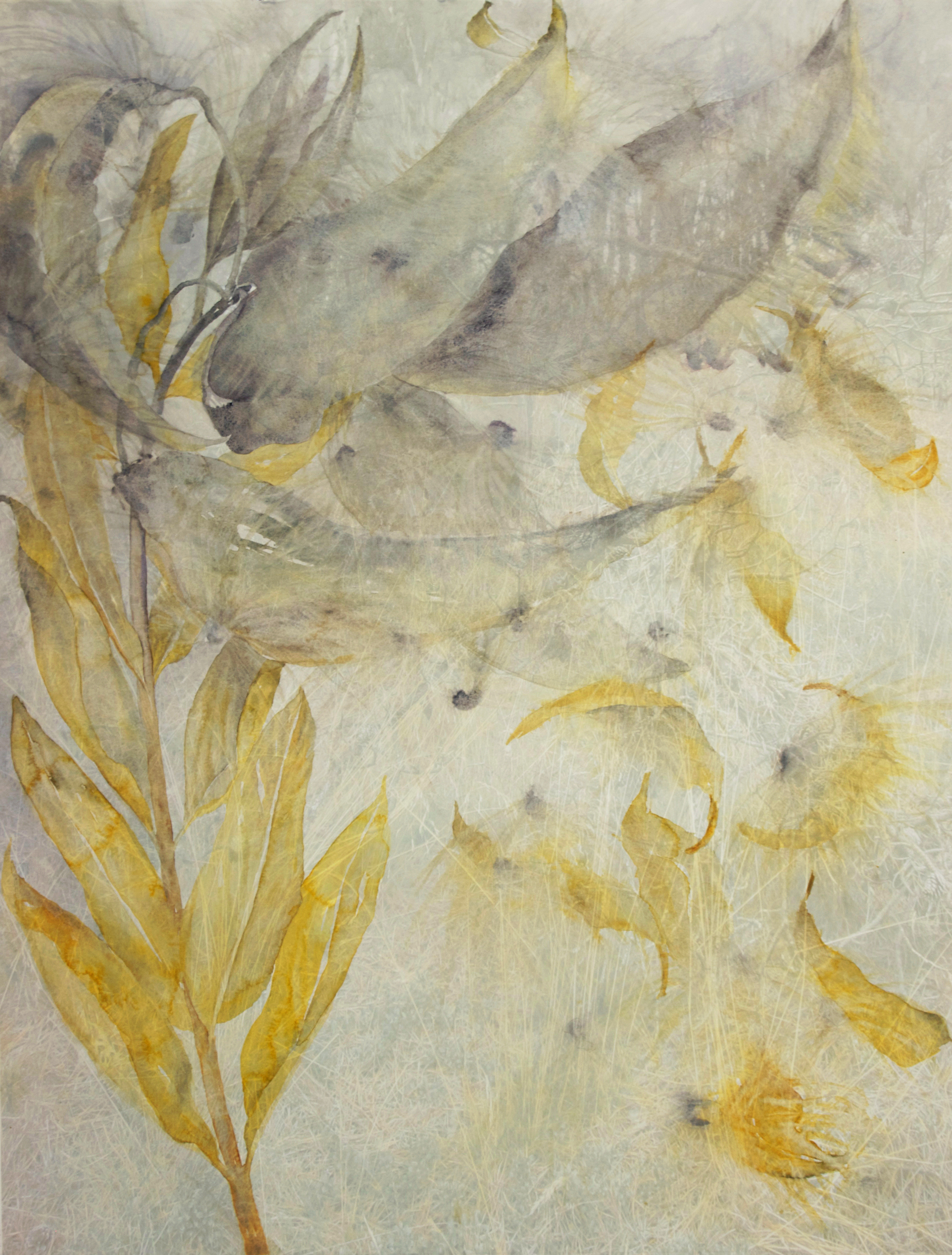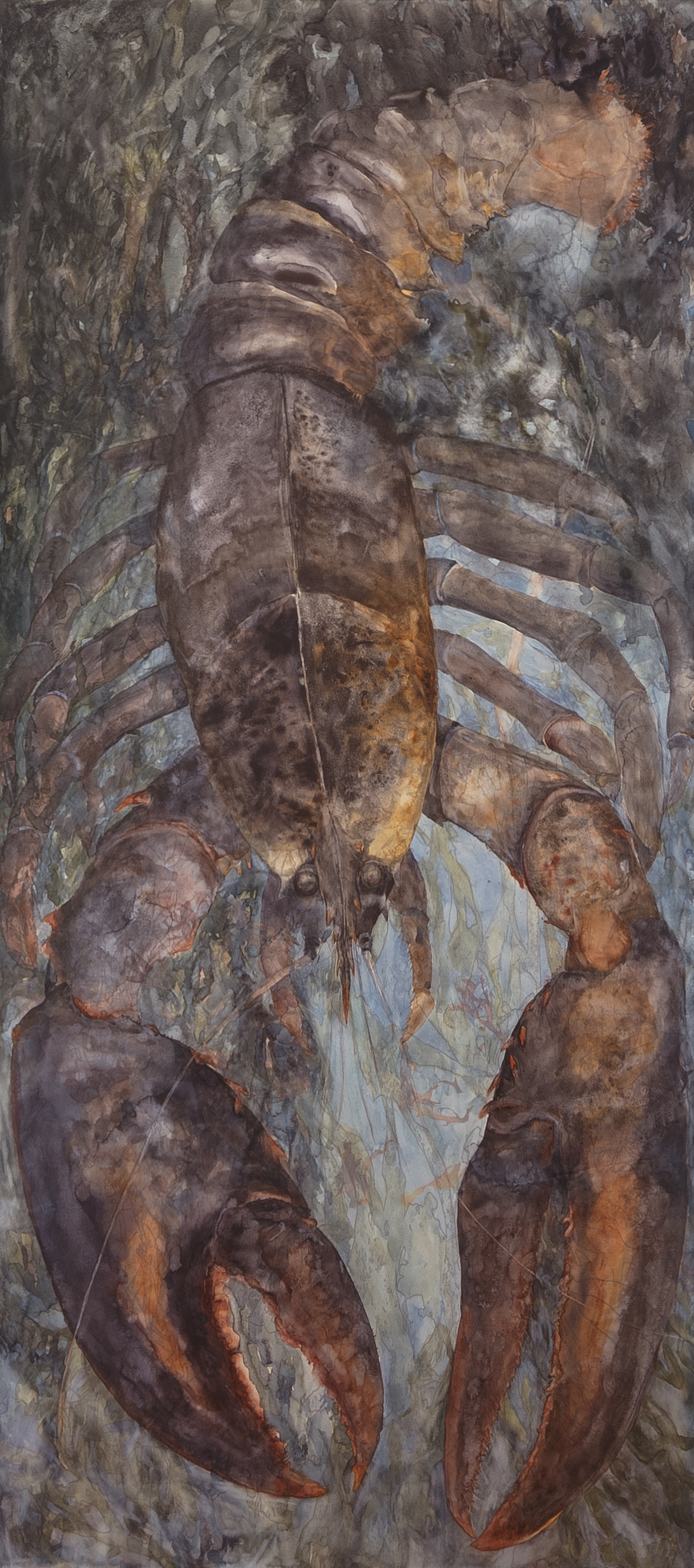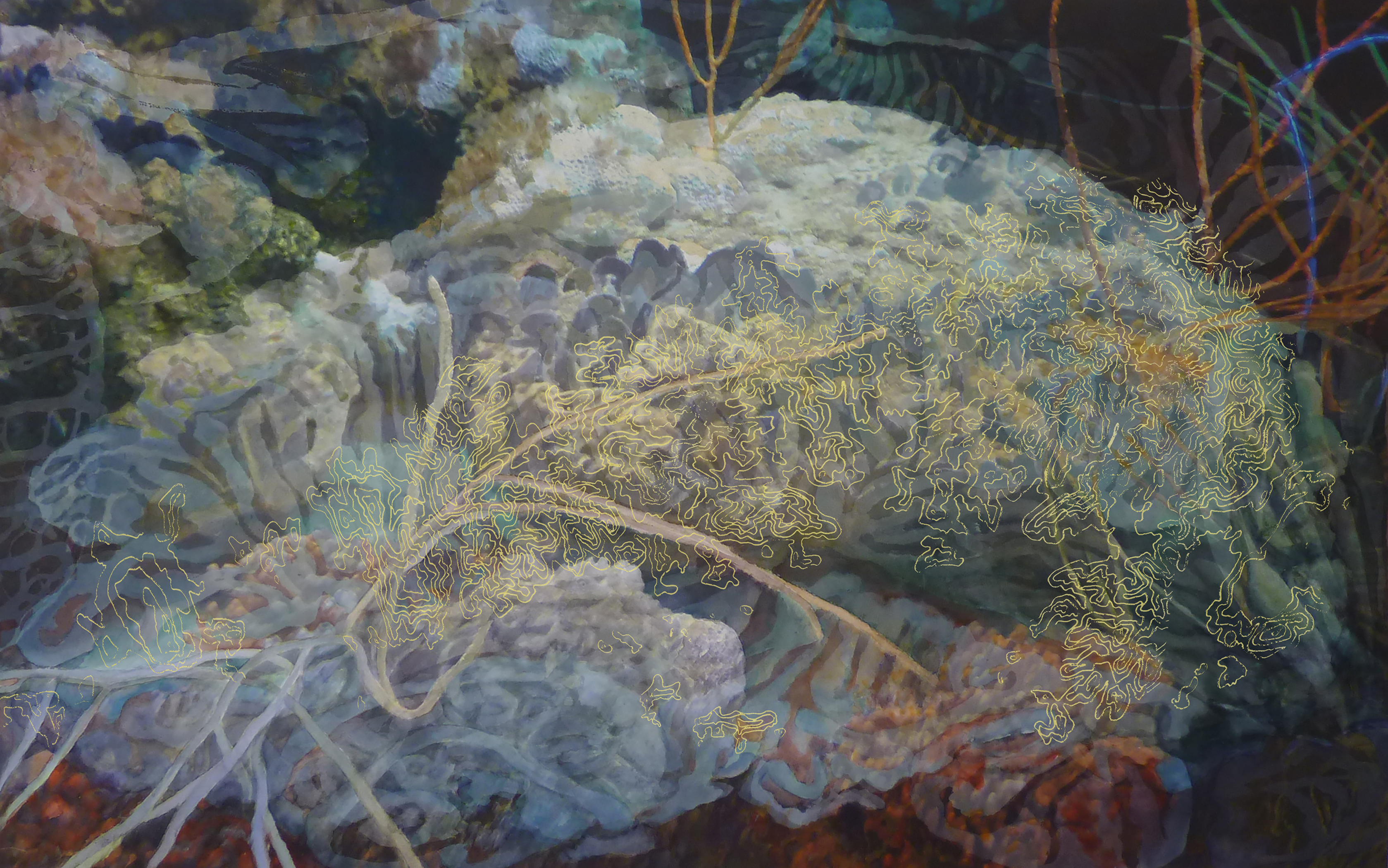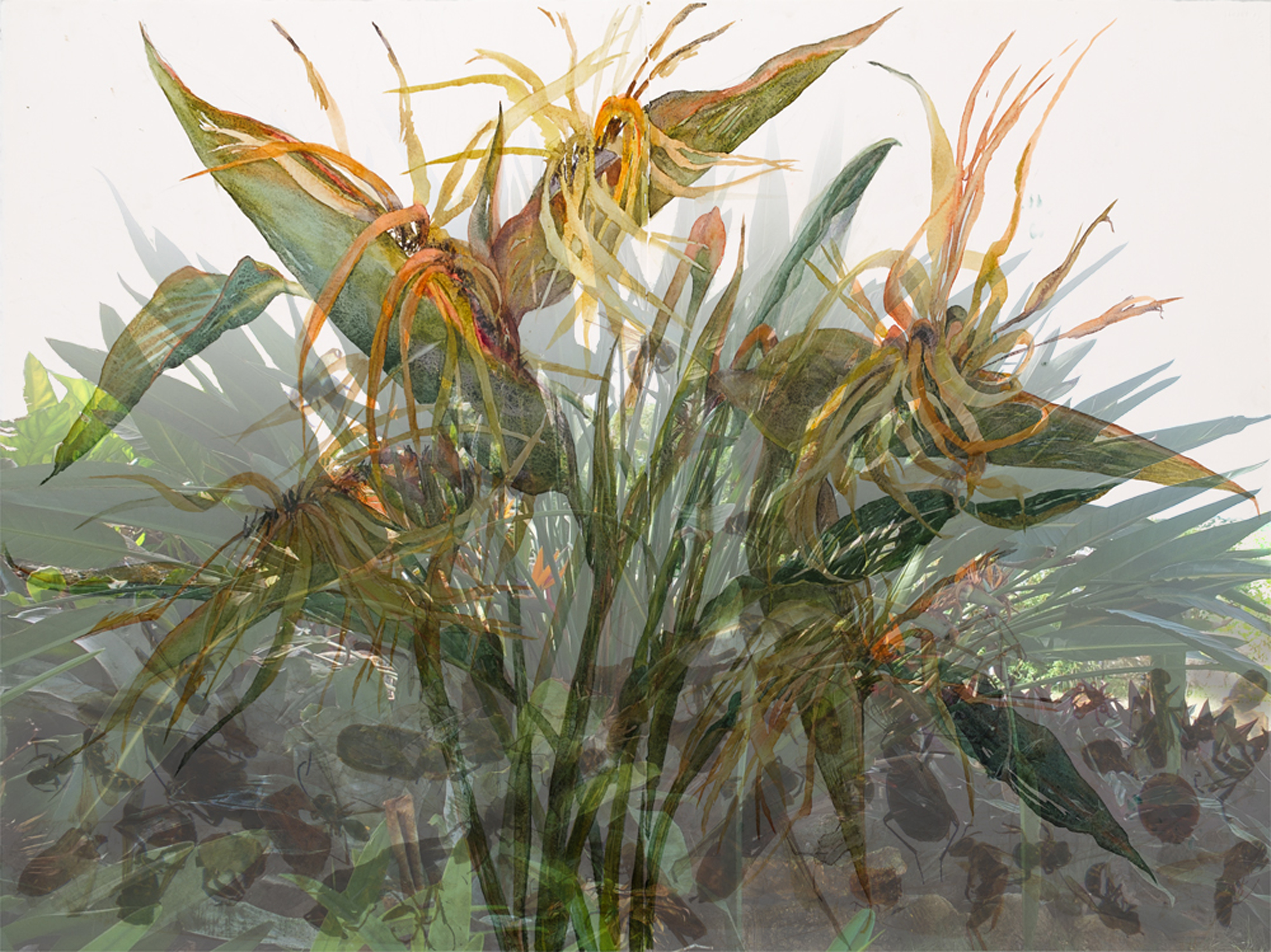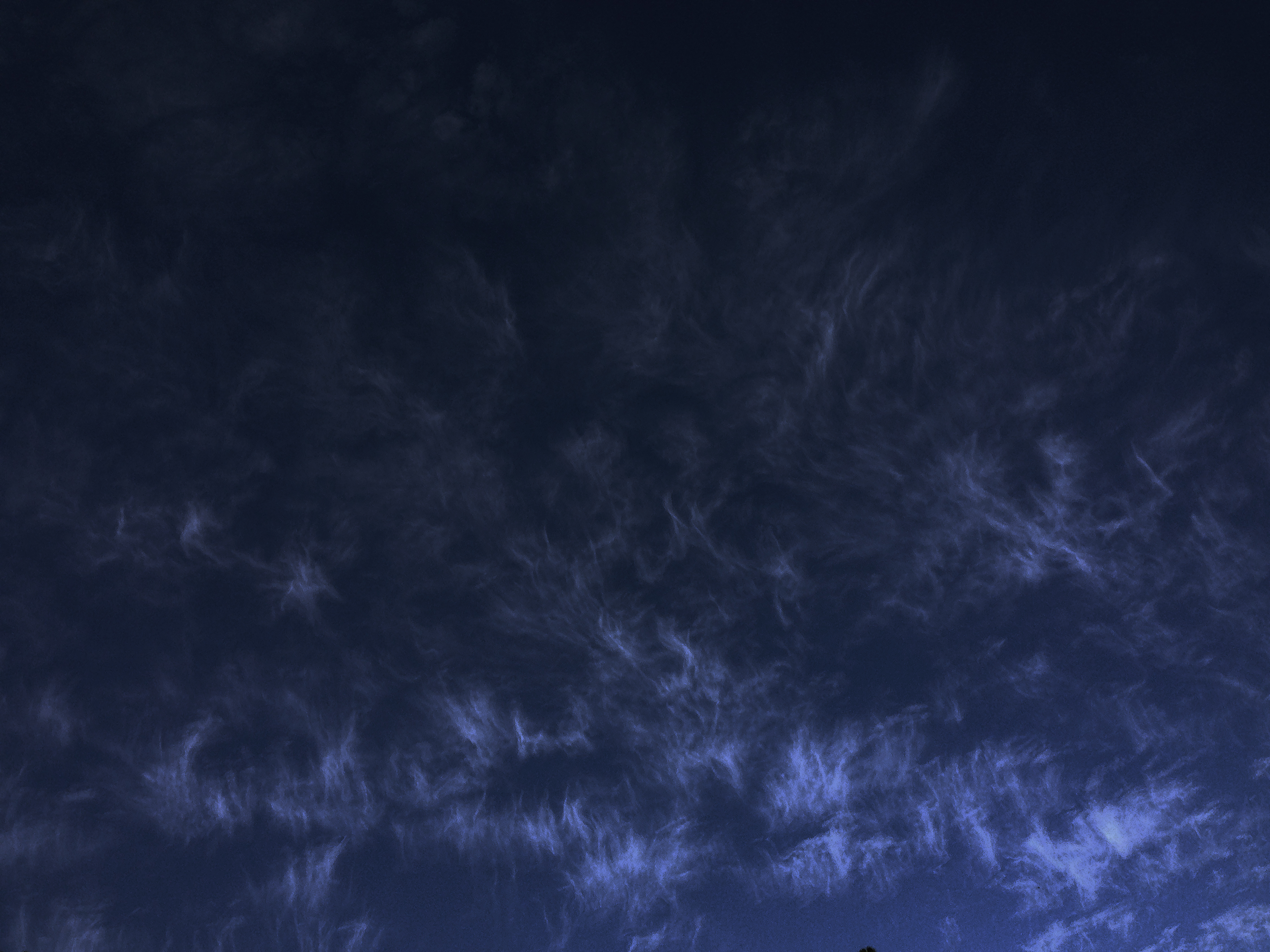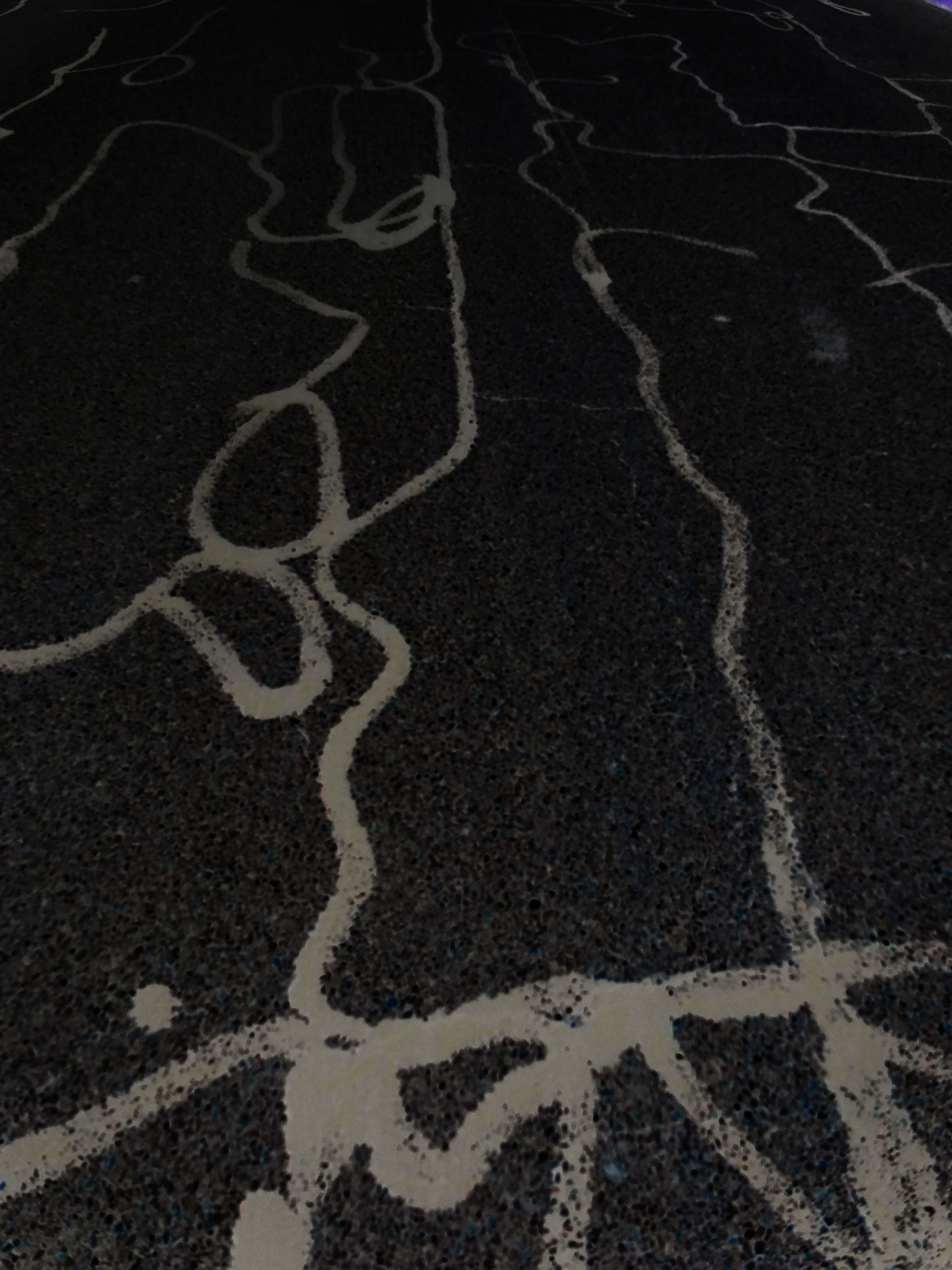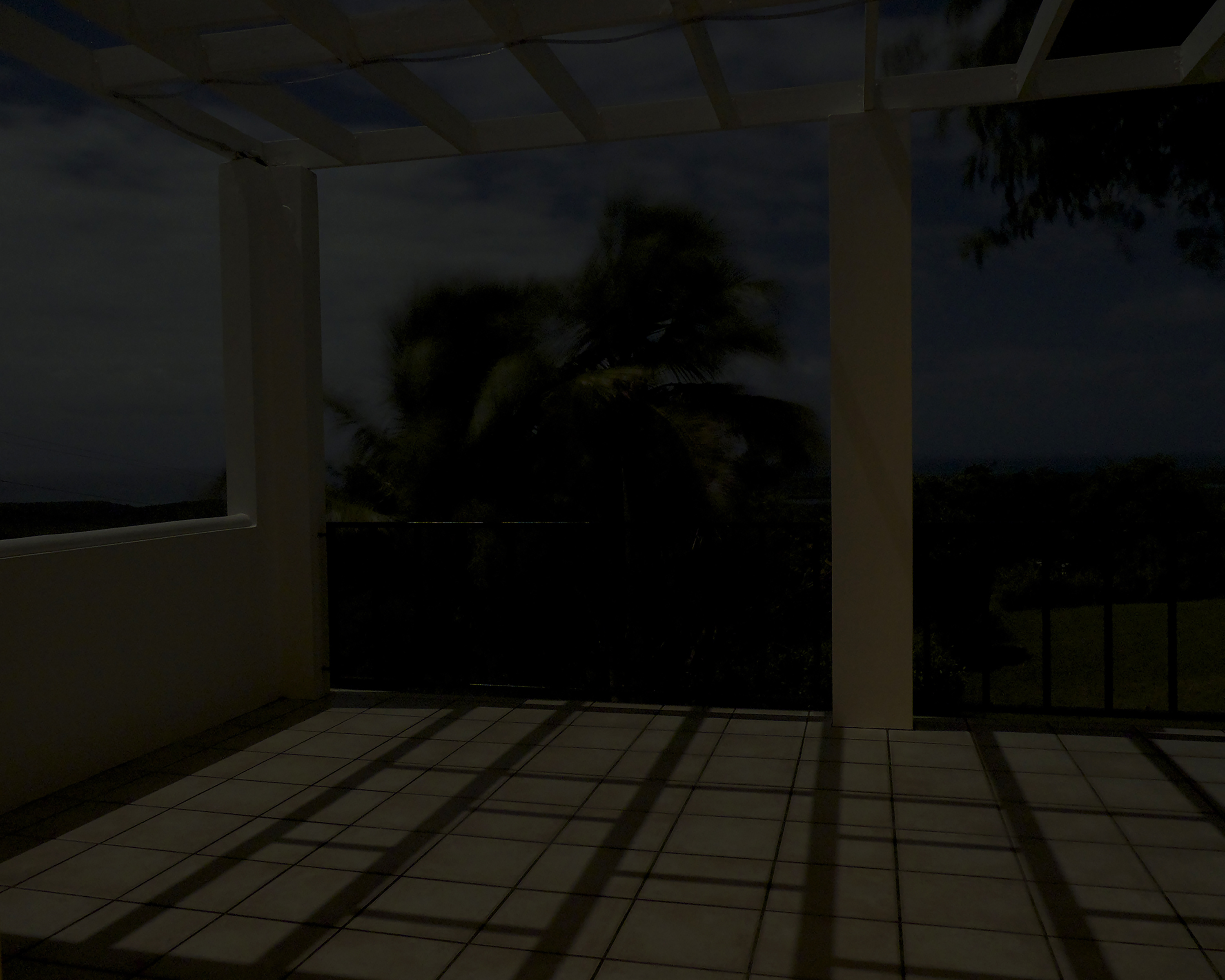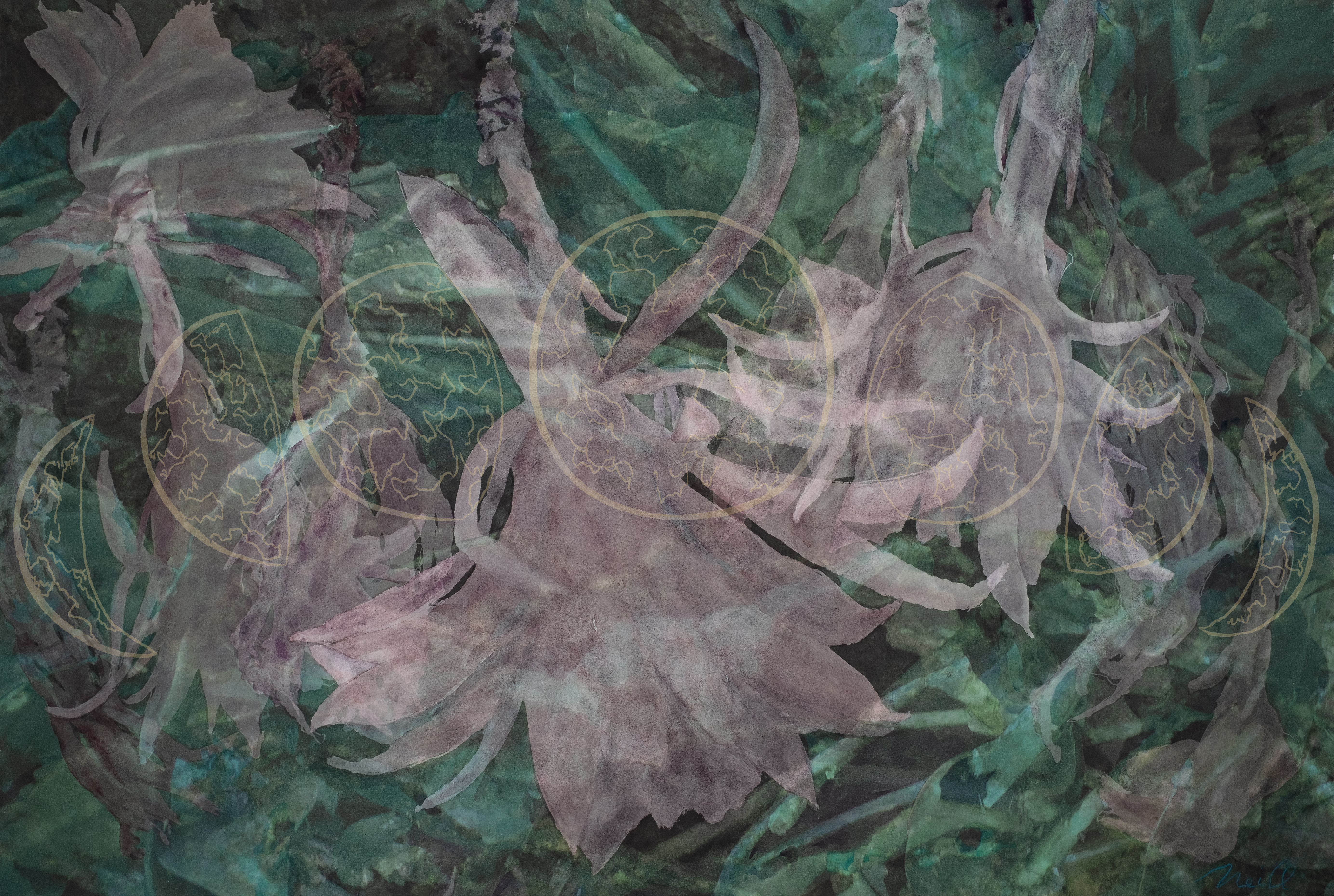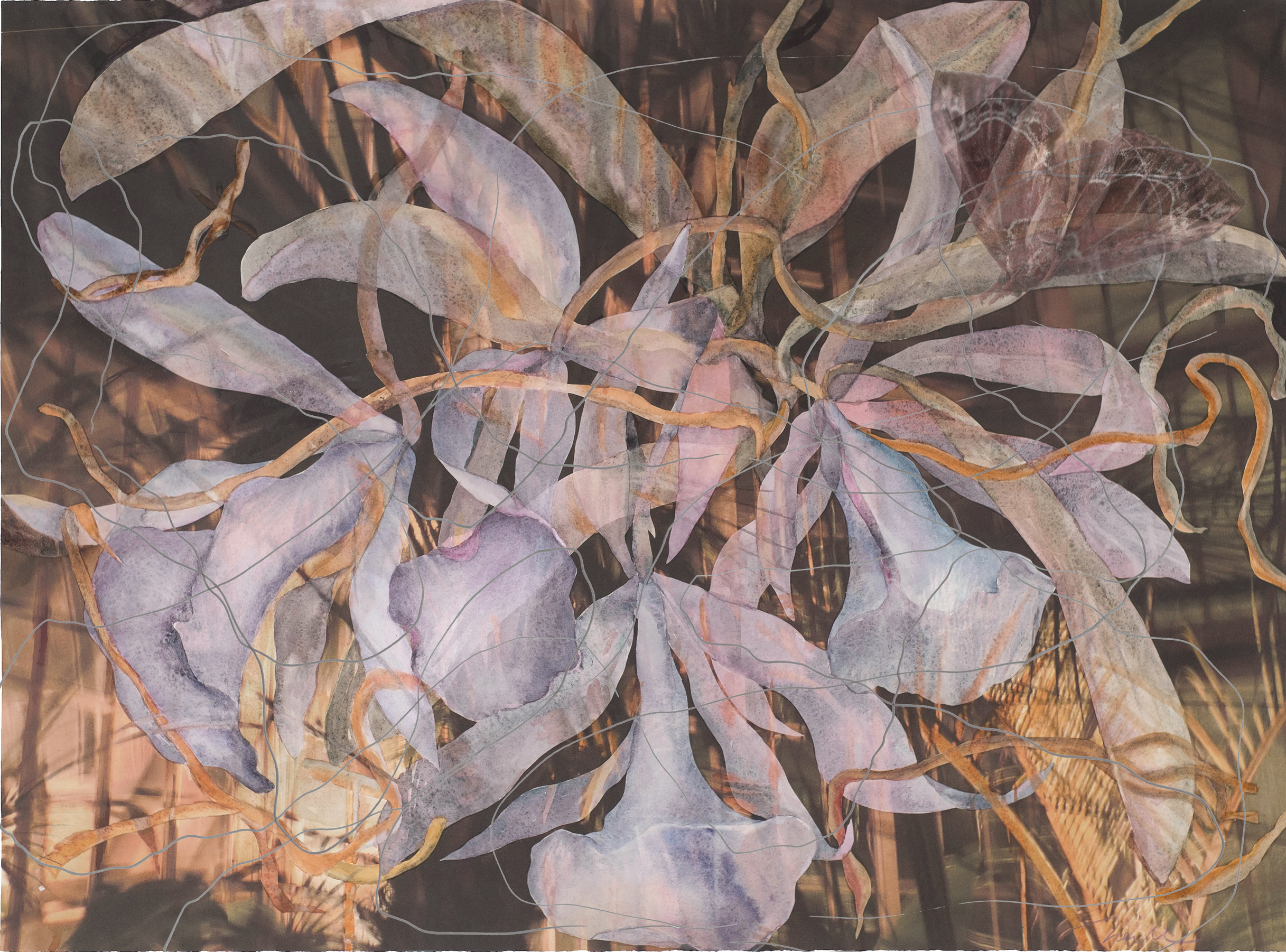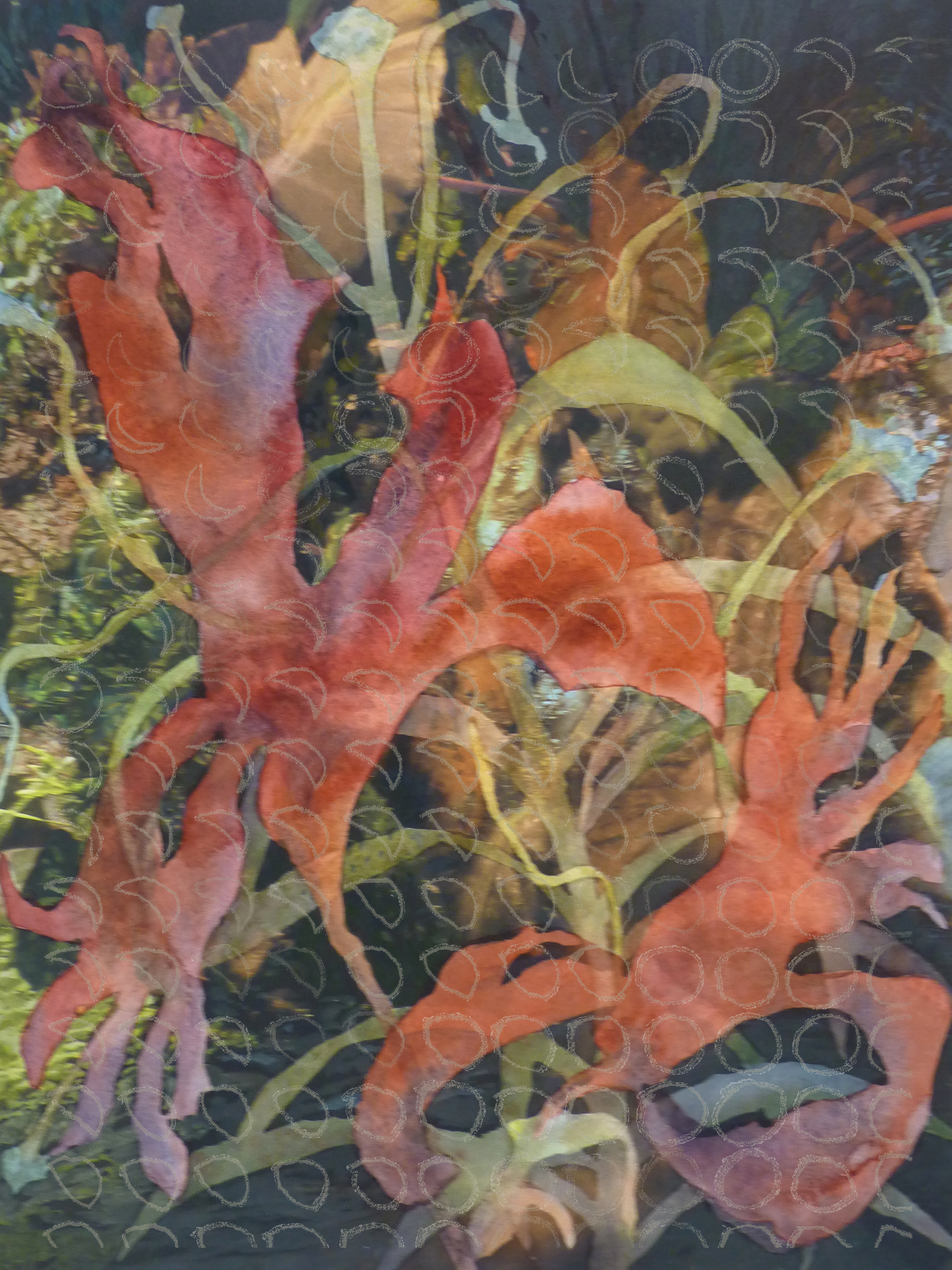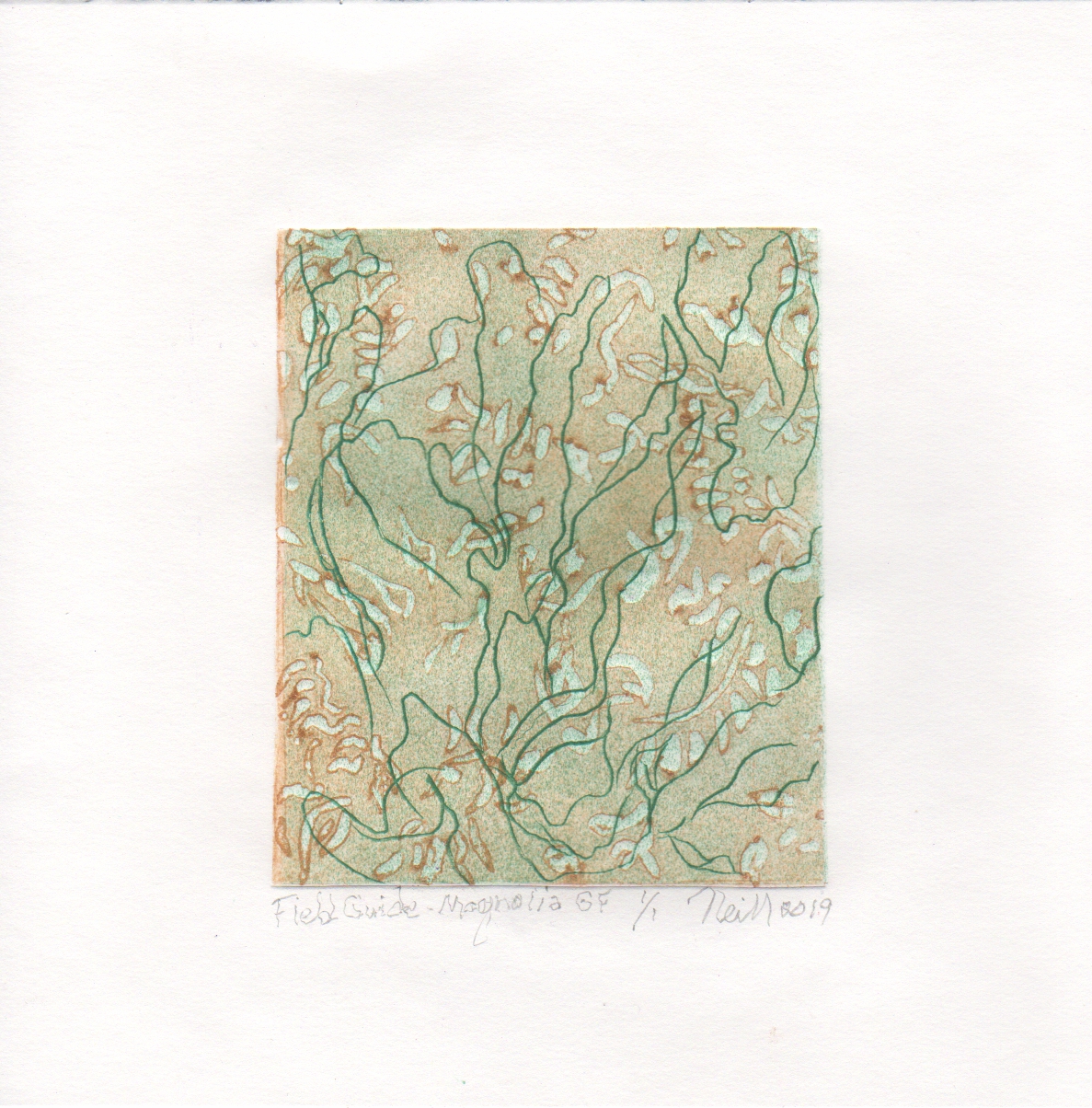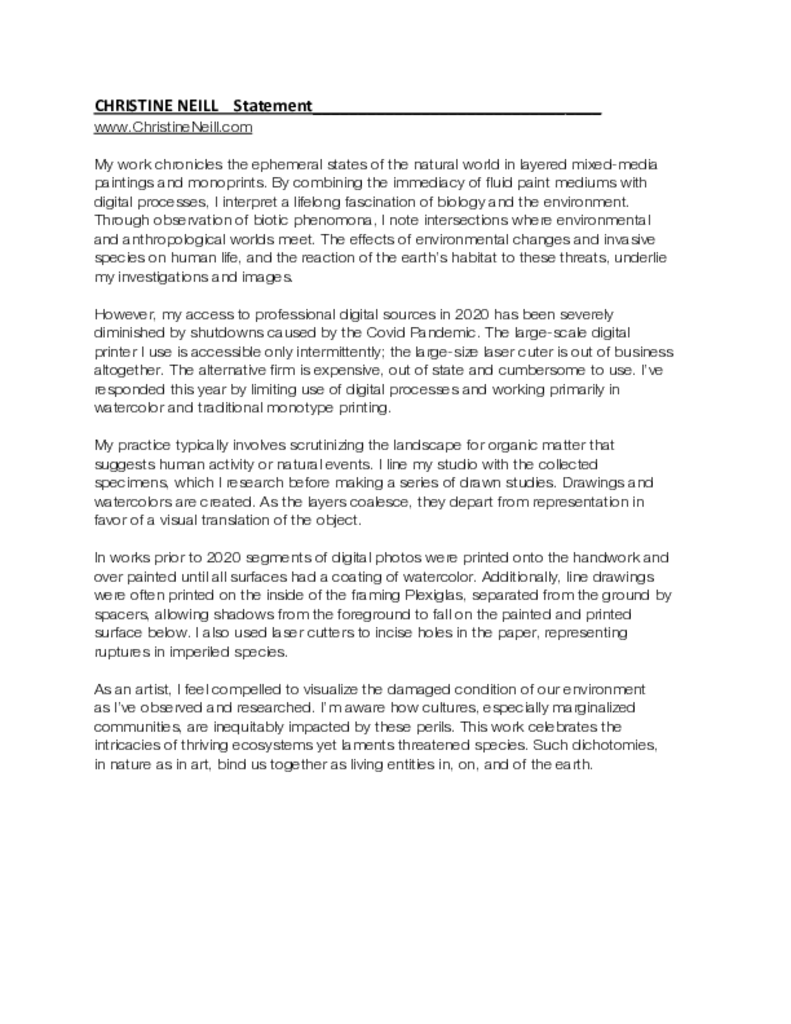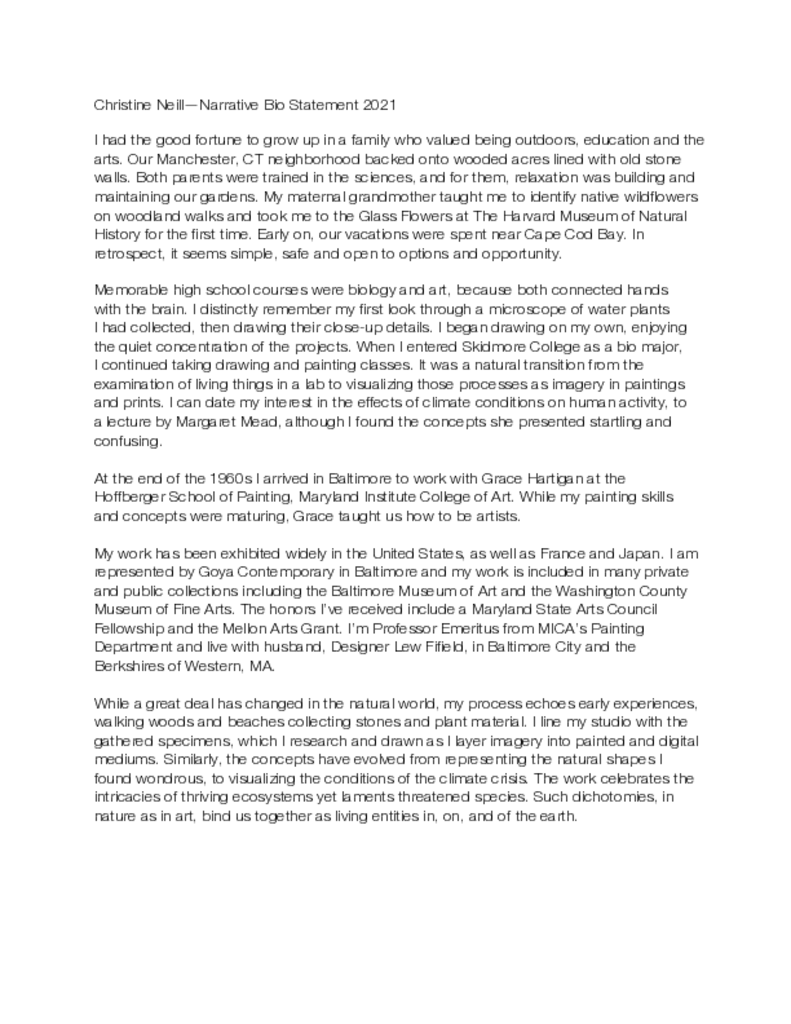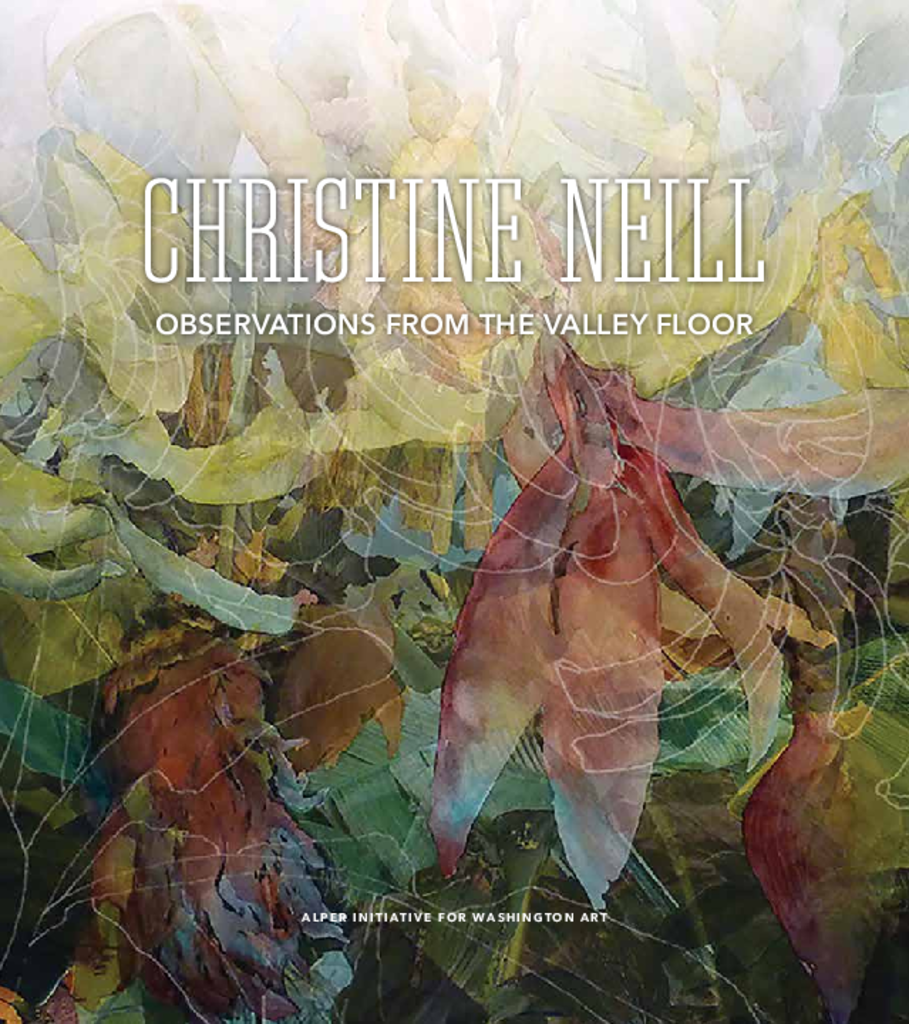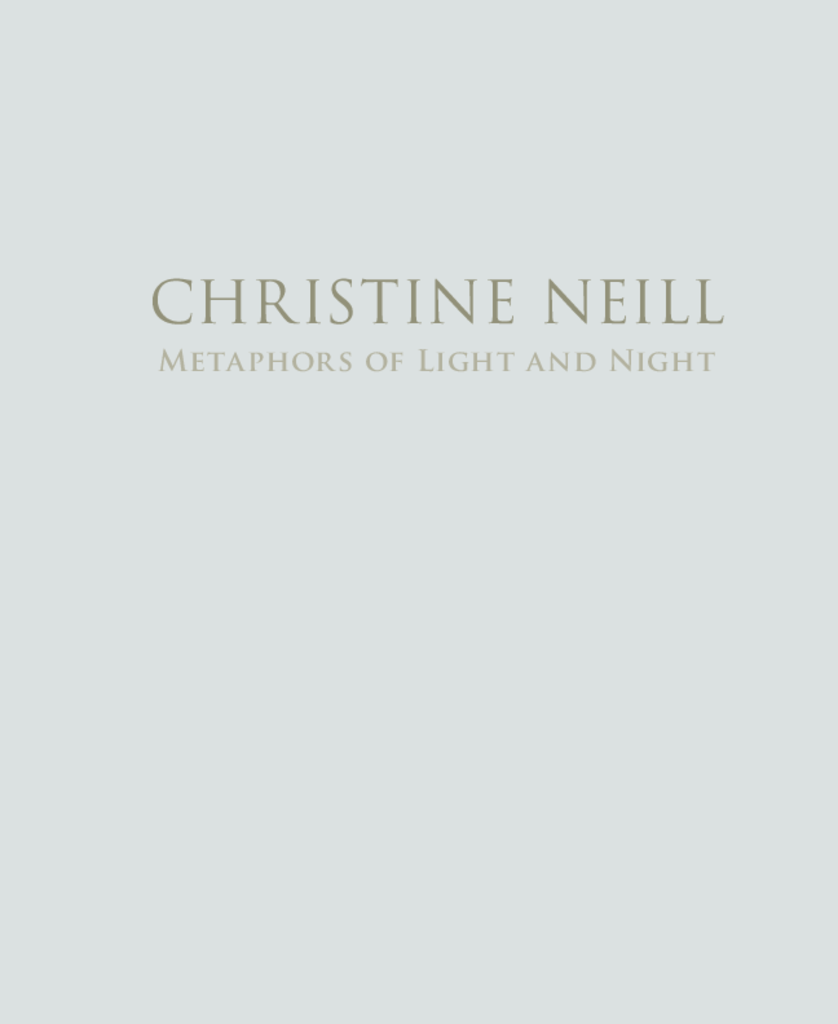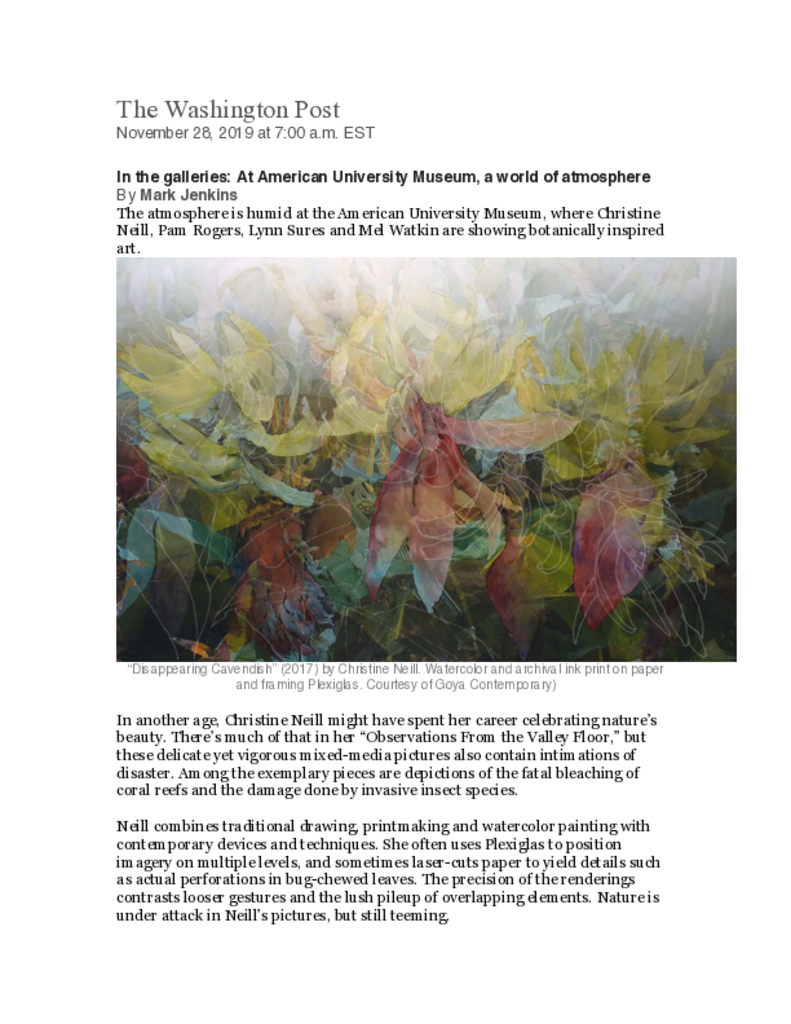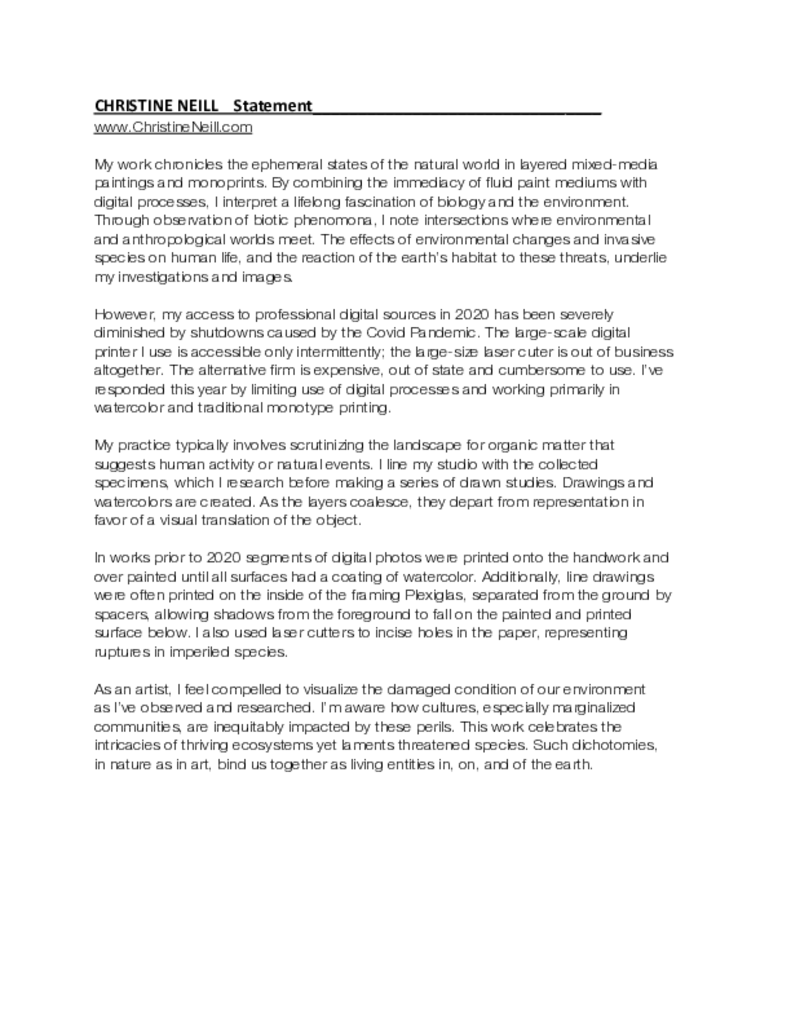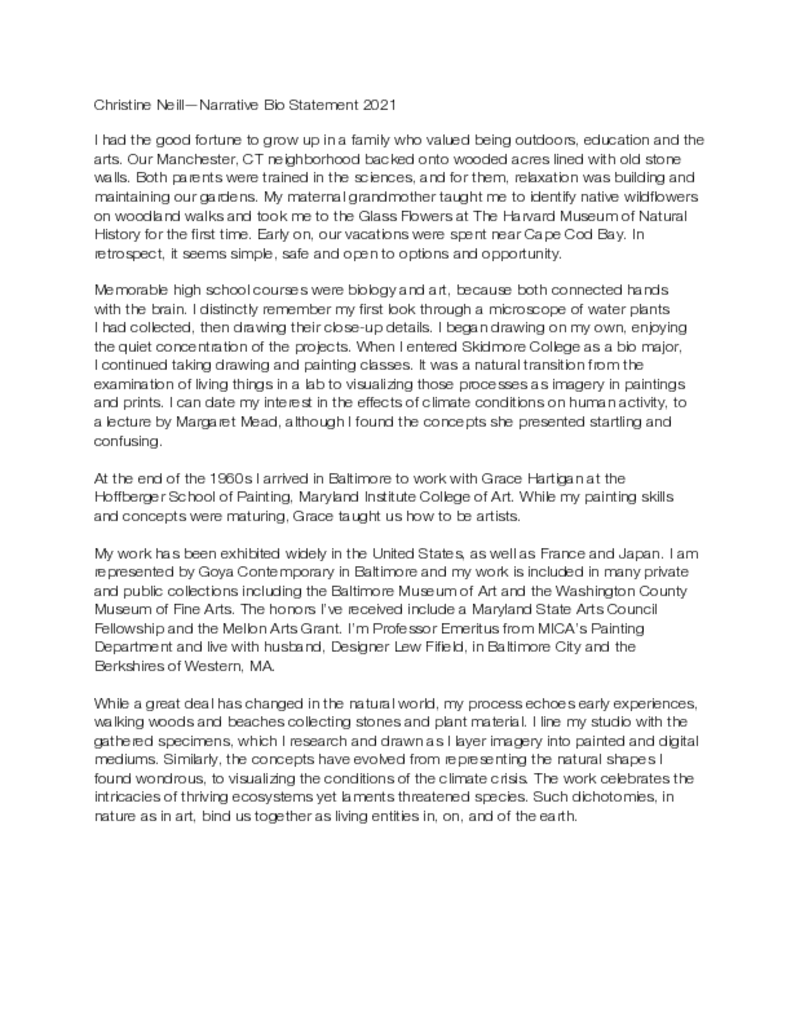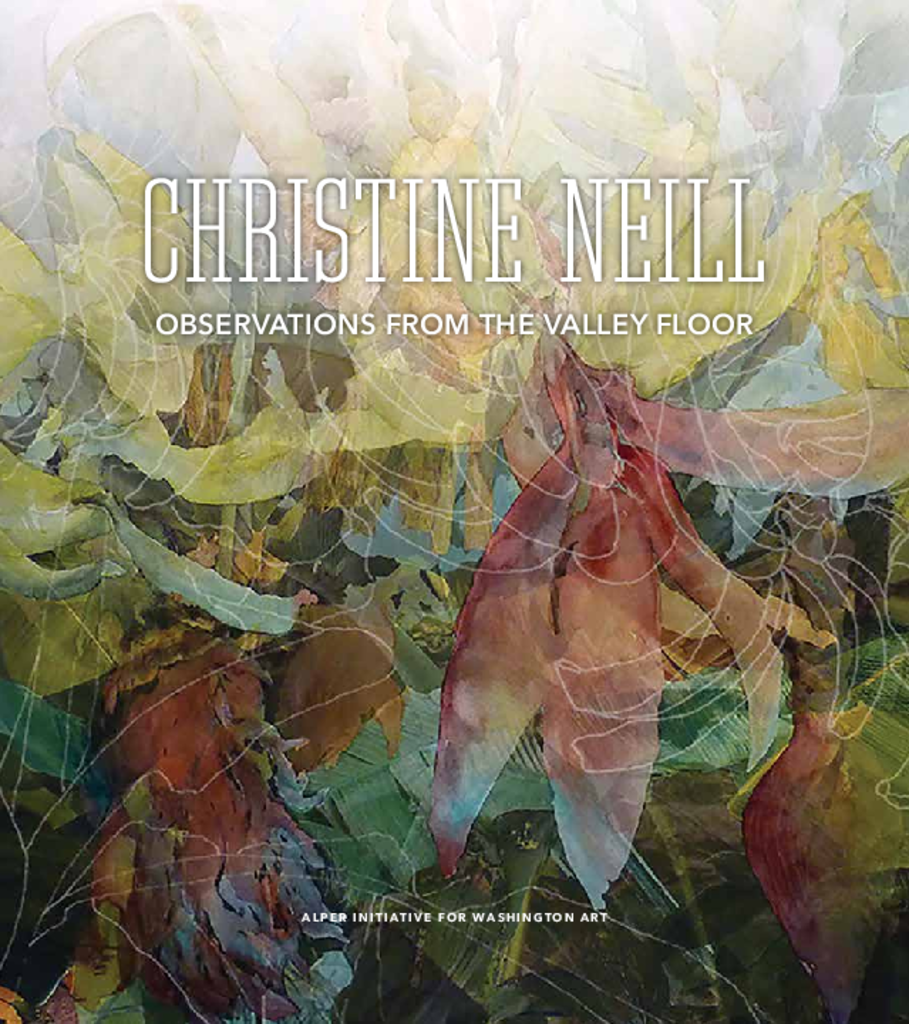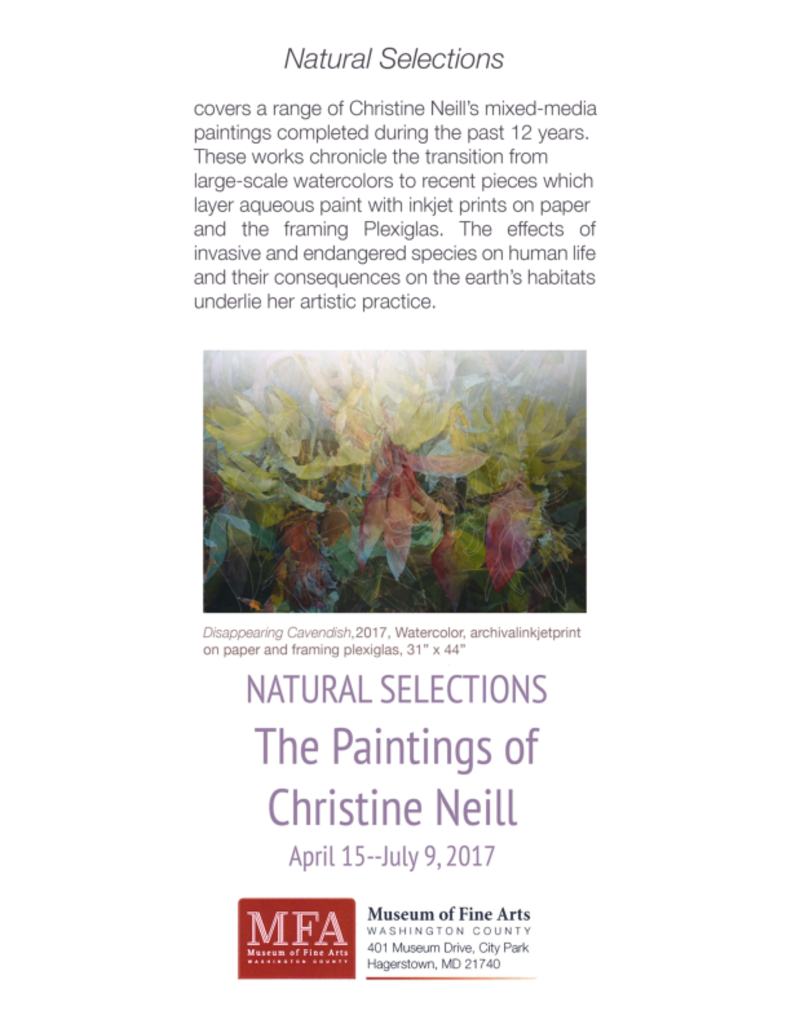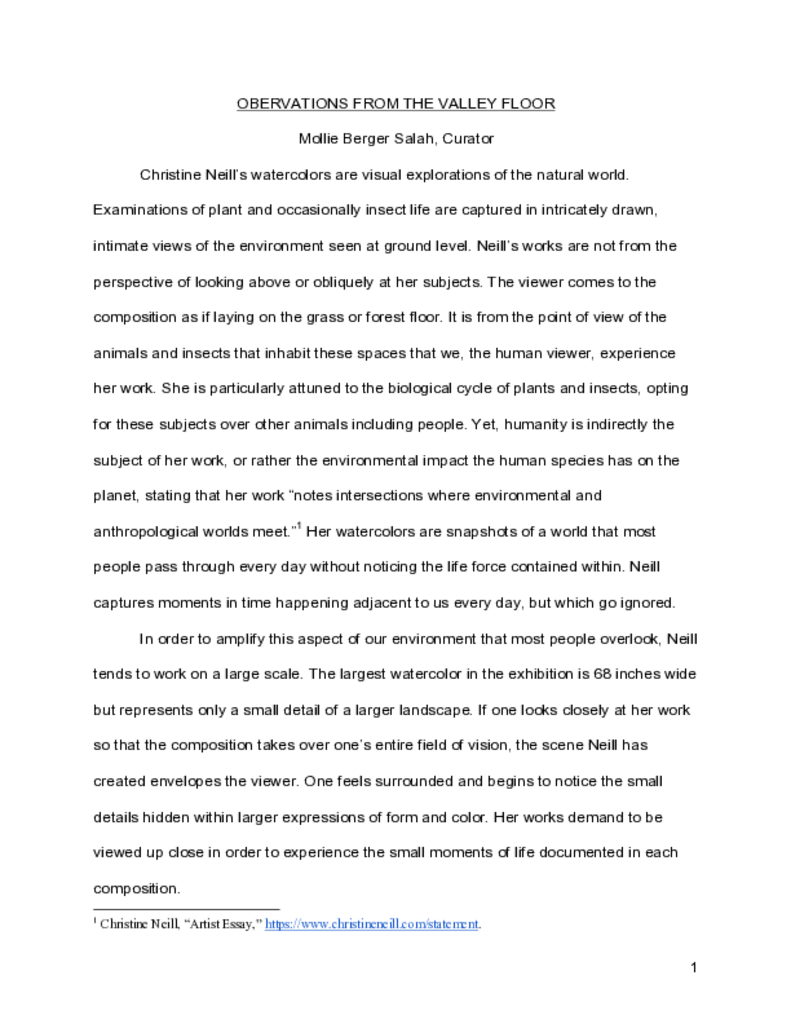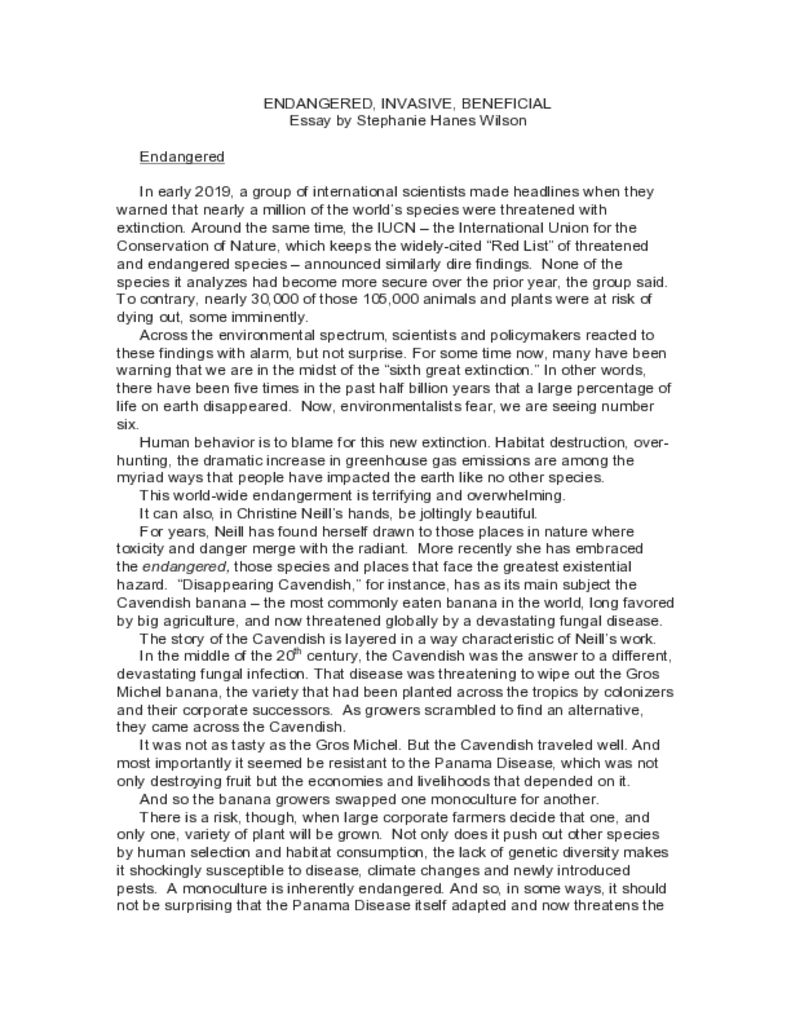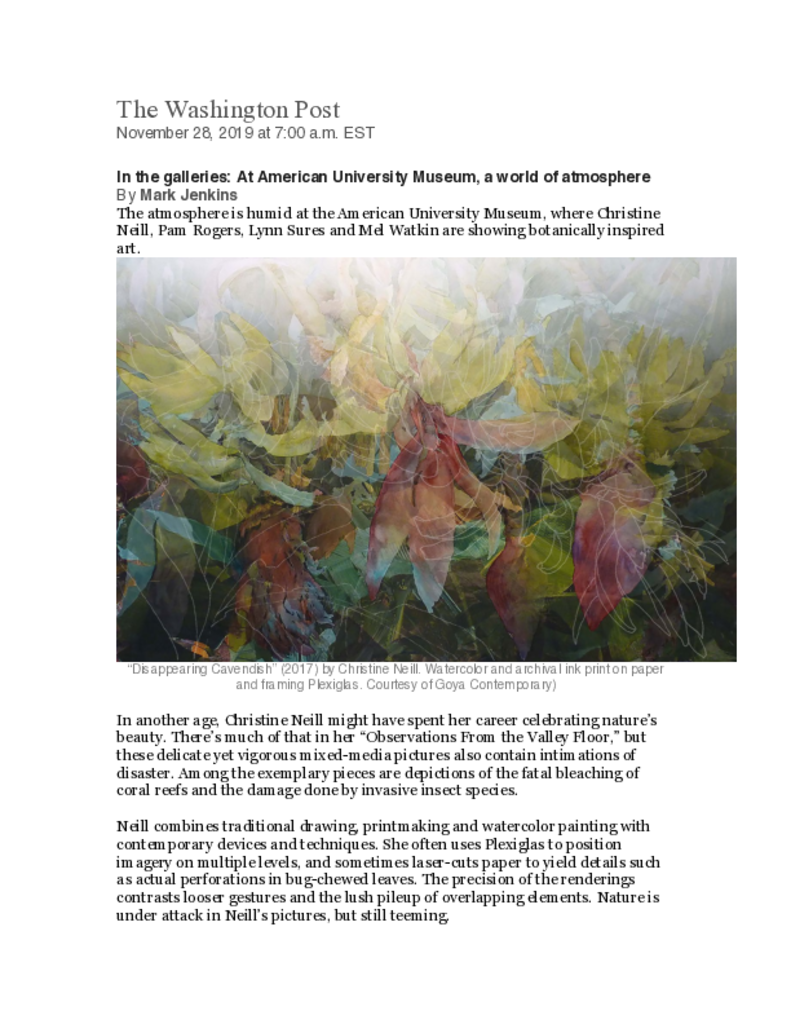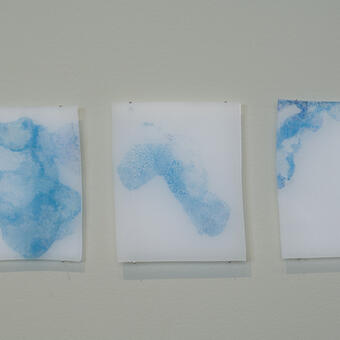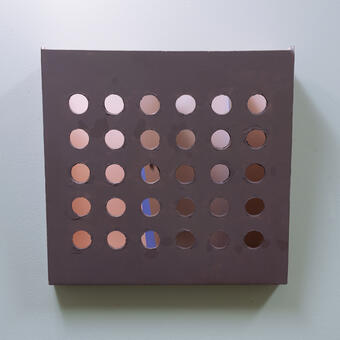About Christine
Baltimore City
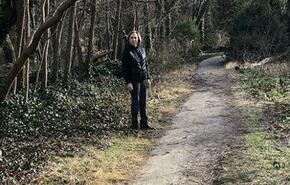
Christine Neill is a nationally exhibited American artist whose work blends motifs of biological examination with visual processes and techniques. The effects of environmental changes and invasive species on human life and the reaction of earth’s habitat to these threats underlie all her images. She is represented by Goya Contemporary, Baltimore, MD.
Neill comments on ways Covid 19 pandemic has impacted her studio work:
I watched with great… more
Jump to a project:
Endangered
My work chronicles the ephemeral states of the natural world and notes the intersections where environmental and anthropological spheres meet.
As an artist, I feel compelled to visualize the damaged condition of our environment as I’ve observed and researched. I’m aware that cultures, especially marginalized communities, are inequitably impacted by these perils.
-
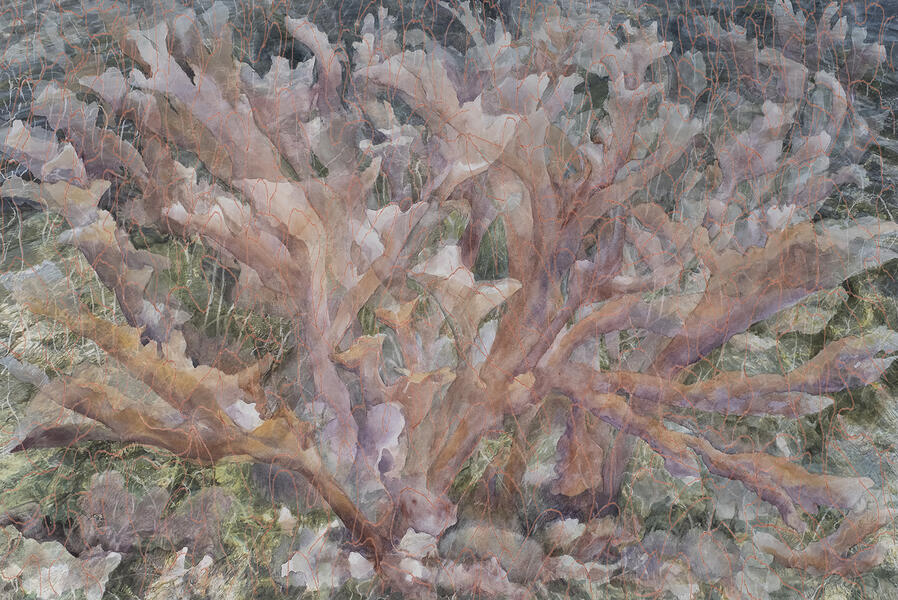 White DeathWhite Death, 2019, Watercolor, archival ink jet print on Arches paper and framing Plexiglas, 34” x 47.75” White death syndrome is decimating coral reefs worldwide. Coral colonies coexist with an algae which nourish the coral. Pollution and warming sea temperatures are killing the algae, thus starving the corals. Dying reefs, devoid of the life giving algae and turning whiteare depicted in watercolor. The Plexi print depicts microscopic zooxanthellae leaving the colonies dissipating as they rise.
White DeathWhite Death, 2019, Watercolor, archival ink jet print on Arches paper and framing Plexiglas, 34” x 47.75” White death syndrome is decimating coral reefs worldwide. Coral colonies coexist with an algae which nourish the coral. Pollution and warming sea temperatures are killing the algae, thus starving the corals. Dying reefs, devoid of the life giving algae and turning whiteare depicted in watercolor. The Plexi print depicts microscopic zooxanthellae leaving the colonies dissipating as they rise. -
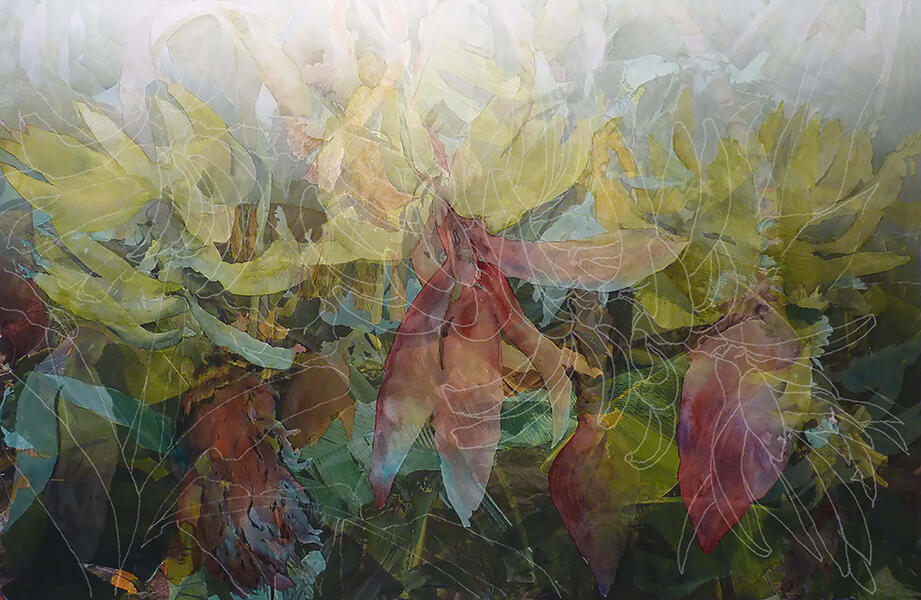 Disappearing CavendishDisappearing Cavendish, 2017, Watercolor, archival pigment print on paper, framing plexiglass, 31” x 44”. Cultivated bananas worldwide are in imminent danger of completely disappearing, damaged by fungal diseases. 500 million people depend on the fruit as a staple food. The global supply is threatened because industry growers have planted just one species, the Cavendish, across continents. The image depicts banana plants vanishing as they recede and the print on Plexiglas is of a line drawing of healthy bananas and it’s inflorescence.
Disappearing CavendishDisappearing Cavendish, 2017, Watercolor, archival pigment print on paper, framing plexiglass, 31” x 44”. Cultivated bananas worldwide are in imminent danger of completely disappearing, damaged by fungal diseases. 500 million people depend on the fruit as a staple food. The global supply is threatened because industry growers have planted just one species, the Cavendish, across continents. The image depicts banana plants vanishing as they recede and the print on Plexiglas is of a line drawing of healthy bananas and it’s inflorescence. -
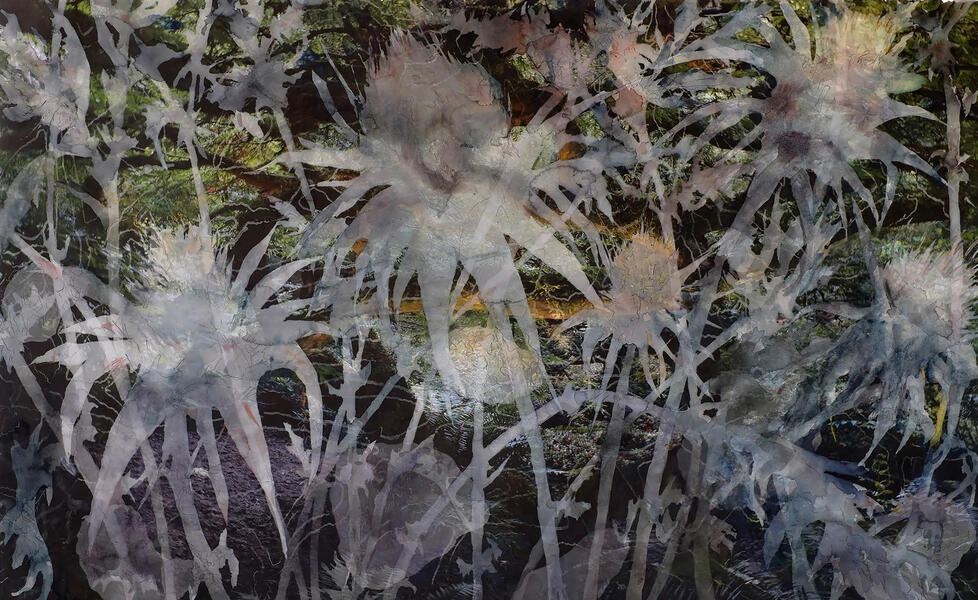 Just WeedsJust Weeds, 2014-15, Watercolor, pencil, archival pigment print on paper, 30” x 45. While the label weed has negative implications it may simply refer to wild plants growing in the wrong place, some of which become desirable when intentionally cultivated. Many weeds are in fact beneficial, having nutritional and medicinal properties or proving crucial to the survival of insects and flora in a specific habitat. Nevertheless, farmers use toxic pesticides to rid thistle from their fields, simultaneously poisoning the soil where crops are planted. Thistles, a large family of plants with many desirous as well as noxious characteristics, were the incentive for this painting..
Just WeedsJust Weeds, 2014-15, Watercolor, pencil, archival pigment print on paper, 30” x 45. While the label weed has negative implications it may simply refer to wild plants growing in the wrong place, some of which become desirable when intentionally cultivated. Many weeds are in fact beneficial, having nutritional and medicinal properties or proving crucial to the survival of insects and flora in a specific habitat. Nevertheless, farmers use toxic pesticides to rid thistle from their fields, simultaneously poisoning the soil where crops are planted. Thistles, a large family of plants with many desirous as well as noxious characteristics, were the incentive for this painting.. -
 Monarch MilkweedMonarch Milkweed, 2009, Watercolor,archival pigment print on paper, 46.5” x 35” The common milkweed, Asclepias syriacia, is crucial for the survival of the majestic monarch butterfly. Here the plant is painted set in situ in a pine forest. Preserving milkweed in North America is essential for the survival of monarchs and "to ensure the sustainability of our food production systems, avoid additional economic impact on the agricultural sector, and protect the health of the environment."
Monarch MilkweedMonarch Milkweed, 2009, Watercolor,archival pigment print on paper, 46.5” x 35” The common milkweed, Asclepias syriacia, is crucial for the survival of the majestic monarch butterfly. Here the plant is painted set in situ in a pine forest. Preserving milkweed in North America is essential for the survival of monarchs and "to ensure the sustainability of our food production systems, avoid additional economic impact on the agricultural sector, and protect the health of the environment." -
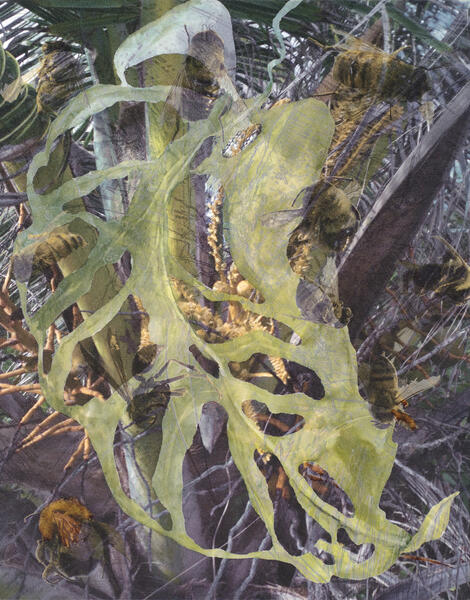 Philo and Palm With Dying BeesPhilo & Palm with dying Bees, 2014, Watercolor, archival pigment print on clayboard, 14” x 11”, Bees, attracted by lush environments, are declining due to multiple risks including increased uses of pesticides, viruses, and loss of habitats. All cause die-off of the hives’ worker bees. Significant economic losses may result because bees are depended upon to pollinate agricultural crops.
Philo and Palm With Dying BeesPhilo & Palm with dying Bees, 2014, Watercolor, archival pigment print on clayboard, 14” x 11”, Bees, attracted by lush environments, are declining due to multiple risks including increased uses of pesticides, viruses, and loss of habitats. All cause die-off of the hives’ worker bees. Significant economic losses may result because bees are depended upon to pollinate agricultural crops. -
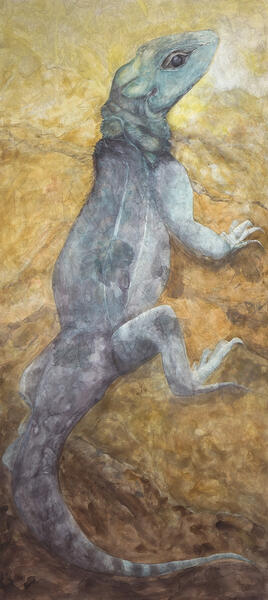 LizardLizard, 2013-14, Watercolor on aquabord panel, archival pigment print, 66" x 30" According to recent research climate changes could cause dozens of lizard species to becoming extinct within the next 50 years due to global temperature increases.
LizardLizard, 2013-14, Watercolor on aquabord panel, archival pigment print, 66" x 30" According to recent research climate changes could cause dozens of lizard species to becoming extinct within the next 50 years due to global temperature increases. -
 LobsterLobster, 2013-14, Watercolor on aquabord Panel, archival pigment print, 66” x 30" Scientists deduce a crippling shell disease, caused by warming ocean temperatures and the breakdown of hard plastics in seawater, is leaving these crustaceans with vulnerable soft shells and affecting the livelihood of fisherman.
LobsterLobster, 2013-14, Watercolor on aquabord Panel, archival pigment print, 66” x 30" Scientists deduce a crippling shell disease, caused by warming ocean temperatures and the breakdown of hard plastics in seawater, is leaving these crustaceans with vulnerable soft shells and affecting the livelihood of fisherman.
Invasive
The works in this project laments the effects of invasive species and environmental changes on imperiled species and human life, and observes the reaction of the earth’s habitat to these threats.
-
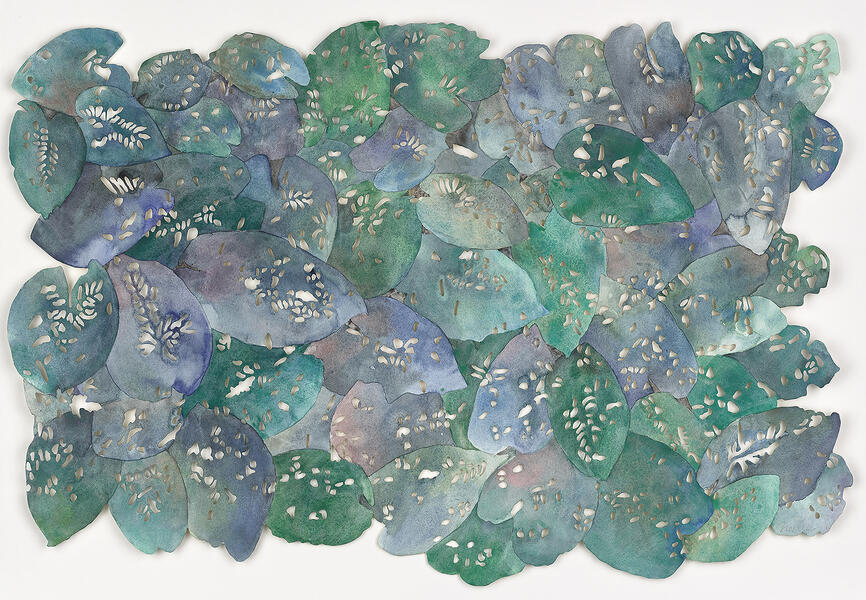 HoleyLeaves-Emerald.jpgInvasive insects, such as the Emerald Ash Borer, chew holes in the leaves of mature trees, defoliating the branches and effectively weakening or killing the trees. The holes were laser cut and cast a shadow on the paper behind.
HoleyLeaves-Emerald.jpgInvasive insects, such as the Emerald Ash Borer, chew holes in the leaves of mature trees, defoliating the branches and effectively weakening or killing the trees. The holes were laser cut and cast a shadow on the paper behind. -
 Death by Fig.jpgThe Strangler Fig invades healthy hosts by casting seeds from the height of its branches which grow downward toward roots and trunks. After several years the encased host will die because it is deprived of the ability to turn sunlight into nutrients. The green drawing of a palm trunk is digitally printed on the inside of the Plexiglas.
Death by Fig.jpgThe Strangler Fig invades healthy hosts by casting seeds from the height of its branches which grow downward toward roots and trunks. After several years the encased host will die because it is deprived of the ability to turn sunlight into nutrients. The green drawing of a palm trunk is digitally printed on the inside of the Plexiglas. -
 Hidden in the Slag.jpgI attended a residency at The Studios of Key West in December ’17-January ’18, three months after destructive Hurricane Irma ripped up the Florida Peninsula, leaving piles of manufactured and plant debris throughout Southern FL. At Everglades NP we questioned a ranger about water flow through the park and creatures found there, asking specifically about Burmese Python. She replied, ”Oh, they’re there, but you’ll never see them.” It became a metaphor as we explored Key West; some were at once obvious, some hidden in the background, intriguing or ugly, sometimes we saw them at once; others were revealed slowly later with a surprise.
Hidden in the Slag.jpgI attended a residency at The Studios of Key West in December ’17-January ’18, three months after destructive Hurricane Irma ripped up the Florida Peninsula, leaving piles of manufactured and plant debris throughout Southern FL. At Everglades NP we questioned a ranger about water flow through the park and creatures found there, asking specifically about Burmese Python. She replied, ”Oh, they’re there, but you’ll never see them.” It became a metaphor as we explored Key West; some were at once obvious, some hidden in the background, intriguing or ugly, sometimes we saw them at once; others were revealed slowly later with a surprise. -
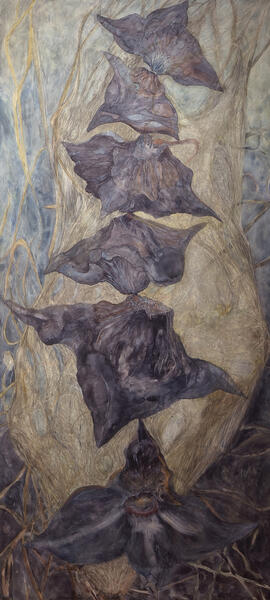 Pods.jpgInvasive Asian Water Chestnuts (inedible), painted in watercolor, are precariously stacked against a digital print ground of harmful giant hogweed and caterpillar tents. These species are non-native and severely threatening the environments in which they have taken hold.
Pods.jpgInvasive Asian Water Chestnuts (inedible), painted in watercolor, are precariously stacked against a digital print ground of harmful giant hogweed and caterpillar tents. These species are non-native and severely threatening the environments in which they have taken hold. -
 Pod InvasivePod Invasive, 2015, Watercolor, archival inkjet print on paper, mounted on panel, 11” x 14” A non-native seedpod, painted in watercolor, sits within layered photographs of the environment which it has invaded and is destroying.
Pod InvasivePod Invasive, 2015, Watercolor, archival inkjet print on paper, mounted on panel, 11” x 14” A non-native seedpod, painted in watercolor, sits within layered photographs of the environment which it has invaded and is destroying.
Beneficial
While the effects of environmental climate changes are well documented and progressive, through collective human effort they can be slowed, possibly reversed. Using the immediacy of fluid paint mediums in tandem with my own photographs to interpret natural shapes and internal structures, I reference antidotes to the dangers and threats.
-
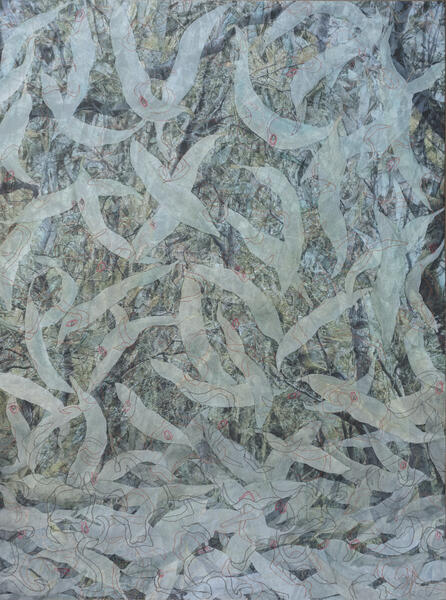 Greenbrae DuffGreenbrae Duff, Watercolor, archival pigmented print on Arches paper and framing Plexiglas, 41.5” 32.5” Lauren R Stevens, writer and environmentalist, describes the importance of duff, “Trees remove carbon from the air. Old trees remove more carbon than young ones. Furthermore, old forests with their deep layer of duff, store as much carbon on the ground as in the trees." With the advent of climate change due to the increase of carbon, forests’ roles are significant. Leaves are painted floating to form duff; drawings of seedpods are printed on the framing Plexiglas.
Greenbrae DuffGreenbrae Duff, Watercolor, archival pigmented print on Arches paper and framing Plexiglas, 41.5” 32.5” Lauren R Stevens, writer and environmentalist, describes the importance of duff, “Trees remove carbon from the air. Old trees remove more carbon than young ones. Furthermore, old forests with their deep layer of duff, store as much carbon on the ground as in the trees." With the advent of climate change due to the increase of carbon, forests’ roles are significant. Leaves are painted floating to form duff; drawings of seedpods are printed on the framing Plexiglas. -
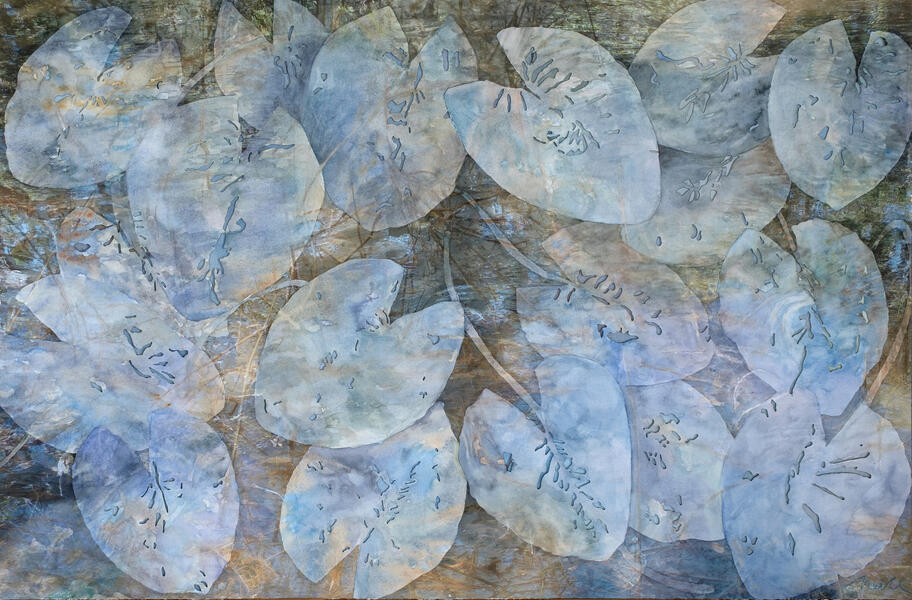 Blue CarbonBlue Carbon, 2019, Watercolor, archival pigment print on laser cut Arches paper, 30” x 45” Blue carbon is the carbon captured and stored in wetland ecosystems such as mangrove forests, seagrass meadows or intertidal saltmarshes. The ecosystems are valued because they hold vast carbon reservoirs and isolate CO2 deposit it in their sediments. The leaves and its environment are painted, holes in the leaves were laser cut and a ground painted behind.
Blue CarbonBlue Carbon, 2019, Watercolor, archival pigment print on laser cut Arches paper, 30” x 45” Blue carbon is the carbon captured and stored in wetland ecosystems such as mangrove forests, seagrass meadows or intertidal saltmarshes. The ecosystems are valued because they hold vast carbon reservoirs and isolate CO2 deposit it in their sediments. The leaves and its environment are painted, holes in the leaves were laser cut and a ground painted behind. -
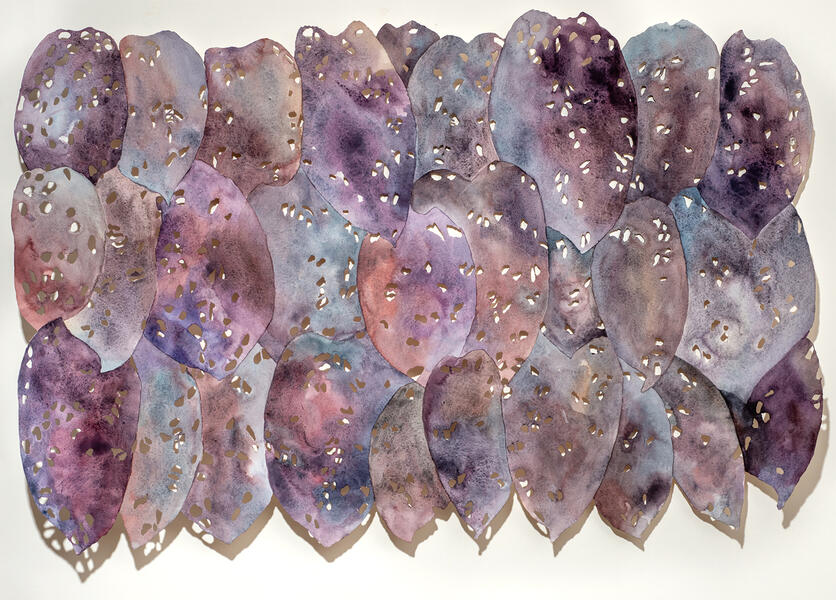 Holey Leaves-VioletHoley Leaves, Violet, 2019, Watercolor on laser cut paper, 24” x 36” By the end of the summer season many plants show evidence of having been eaten by insects in preparation for winter hibernation. The species live in healthy symbiosis. The paper was laser cut before the leaves were drawn and painted.
Holey Leaves-VioletHoley Leaves, Violet, 2019, Watercolor on laser cut paper, 24” x 36” By the end of the summer season many plants show evidence of having been eaten by insects in preparation for winter hibernation. The species live in healthy symbiosis. The paper was laser cut before the leaves were drawn and painted. -
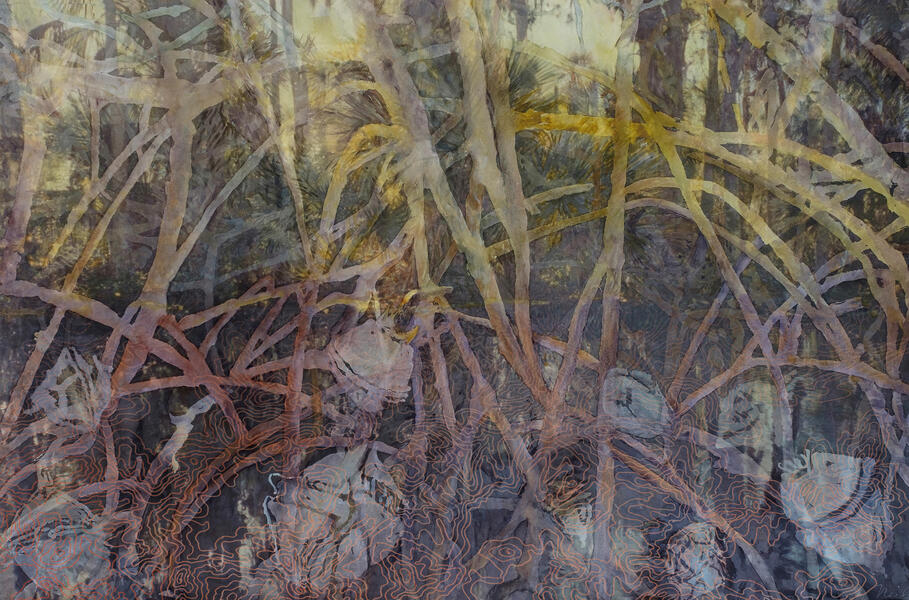 Mangrove ForestMangrove Forest, 2017, Watercolor, archival pigment print on paper, framing plexiglas, 31” x 44.75” Mangroves absorb massive amounts of nutrients, thereby improving water purity and providing crucial assistance to both land and water animals & plants. The mangrove groves protect coast lines from storm erosion. The print on the Plexi appearing at the bottom half of the painting are bathymetric contours delineating the ocean floor.
Mangrove ForestMangrove Forest, 2017, Watercolor, archival pigment print on paper, framing plexiglas, 31” x 44.75” Mangroves absorb massive amounts of nutrients, thereby improving water purity and providing crucial assistance to both land and water animals & plants. The mangrove groves protect coast lines from storm erosion. The print on the Plexi appearing at the bottom half of the painting are bathymetric contours delineating the ocean floor. -
 ReefReef, 2017, Watercolor, archival pigment print on paper & Plexiglas, 29” x 44” The survival of many undersea creatures depends on the steady ebb and flow of oceantides. Rising sea levels threaten the protective costal reefs and species that live in the intertidal zone. Depicted in watercolor are a variety of coral species and drawings of bathymetric contours of coastal ocean beds are printed on the framing Plexiglas.
ReefReef, 2017, Watercolor, archival pigment print on paper & Plexiglas, 29” x 44” The survival of many undersea creatures depends on the steady ebb and flow of oceantides. Rising sea levels threaten the protective costal reefs and species that live in the intertidal zone. Depicted in watercolor are a variety of coral species and drawings of bathymetric contours of coastal ocean beds are printed on the framing Plexiglas. -
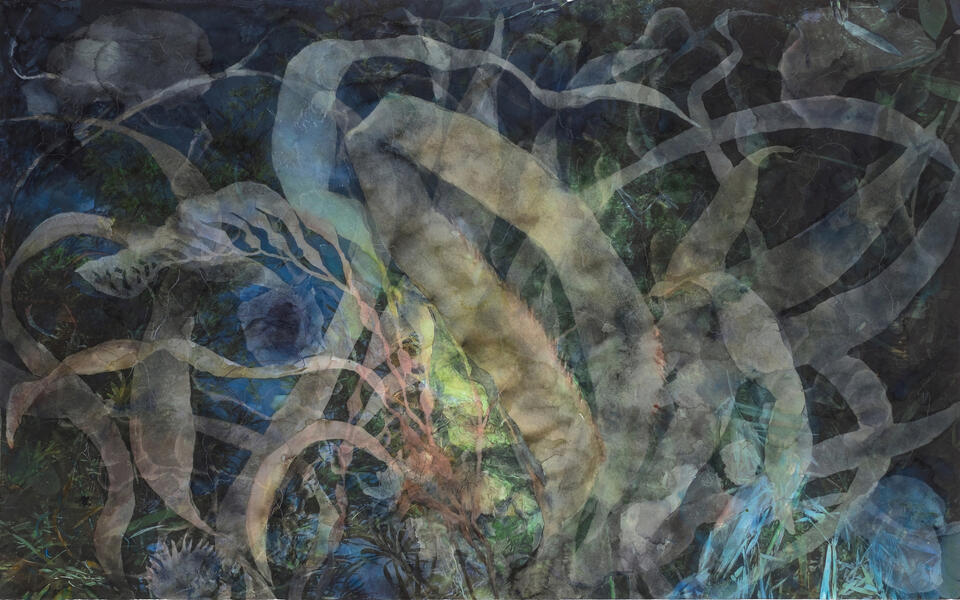 Kelp FieldsKelp Field, 2015, Watercolor, pencil, archival pigment print on paper, 30” x 48” Underwater kelp forests are vigorous ecosystems that provide essential refuge for marine habitats. Painted among the among the thriving kelp are threatened species that will degrade without protection.
Kelp FieldsKelp Field, 2015, Watercolor, pencil, archival pigment print on paper, 30” x 48” Underwater kelp forests are vigorous ecosystems that provide essential refuge for marine habitats. Painted among the among the thriving kelp are threatened species that will degrade without protection. -
 The Other Side of ParadiseOther Side of Paradise, 2013, Watercolor, archival pigment print on paper, framing plexiglass, 31” x 44”, The stalks and blossoming pods of Strelizia reganie, commonly known as Bird of Paradise, were painted in watercolor and a photo of the leaves and ground was printed onto the painting. Often ignored is the plant’s understory in which the crawling creatures and decay exist, essential to the organism's well being. These are depicted on the framing Plexiglas.
The Other Side of ParadiseOther Side of Paradise, 2013, Watercolor, archival pigment print on paper, framing plexiglass, 31” x 44”, The stalks and blossoming pods of Strelizia reganie, commonly known as Bird of Paradise, were painted in watercolor and a photo of the leaves and ground was printed onto the painting. Often ignored is the plant’s understory in which the crawling creatures and decay exist, essential to the organism's well being. These are depicted on the framing Plexiglas. -
 Five Stages of the Palm with BeesFive Stages of the Palm with Bees, 2012-14, Watercolor, archival pigment print on paper, 29” x 63”, Painted stalks, buds, blossoms and seedpods of a palm tree are layered with a digital photo of palm fronds viewed from above. Swarming bees are printed on the inside of the Plexiglas. Palms are simultaneously in the process of reproducing and dying. Healthy swarming bees, crucial to the life cycle of not only palms, but numerous other plants, are printed on the inside of the Plexiglas.
Five Stages of the Palm with BeesFive Stages of the Palm with Bees, 2012-14, Watercolor, archival pigment print on paper, 29” x 63”, Painted stalks, buds, blossoms and seedpods of a palm tree are layered with a digital photo of palm fronds viewed from above. Swarming bees are printed on the inside of the Plexiglas. Palms are simultaneously in the process of reproducing and dying. Healthy swarming bees, crucial to the life cycle of not only palms, but numerous other plants, are printed on the inside of the Plexiglas. -
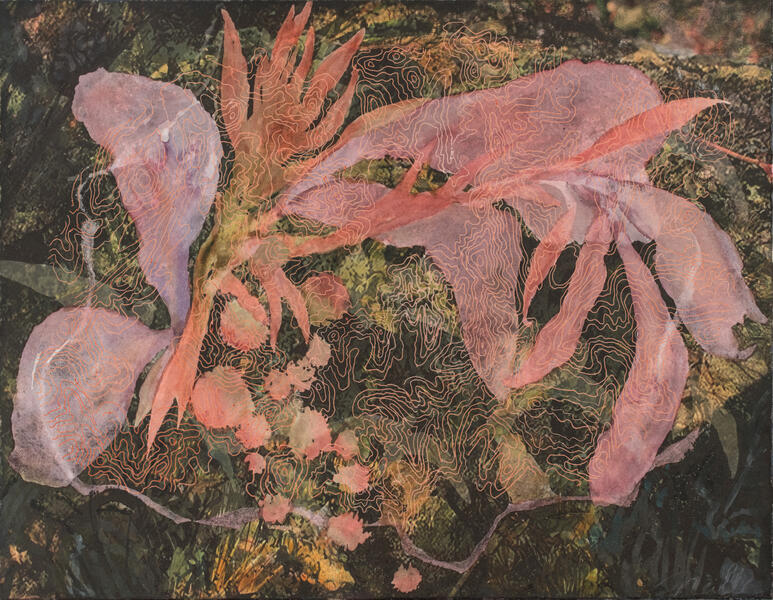 Canna CircleCanna Circle, 2017, Watercolor and archival ink print on paper and framing Plexiglas, 11” x 14x” Canna blossoms and buds are painted withing a favorable environment. An ancient plant with many human uses, canna are also being studied for their ability to eliminate undesirable pollutants in wetlands due to of their tolerance to contaminants. The print on Plexi is a topographical map of farming land.
Canna CircleCanna Circle, 2017, Watercolor and archival ink print on paper and framing Plexiglas, 11” x 14x” Canna blossoms and buds are painted withing a favorable environment. An ancient plant with many human uses, canna are also being studied for their ability to eliminate undesirable pollutants in wetlands due to of their tolerance to contaminants. The print on Plexi is a topographical map of farming land. -
 Balance of Substance, Balance of EssenceBalance of Substance, Balance of Essence, 2011, Watercolor on paper, 30”x22” These stacks of stones are painted to balance visually, if not physically, like the balance we try to maintain in our lives, our artistic expressions, the environment, our social and political structures.
Balance of Substance, Balance of EssenceBalance of Substance, Balance of Essence, 2011, Watercolor on paper, 30”x22” These stacks of stones are painted to balance visually, if not physically, like the balance we try to maintain in our lives, our artistic expressions, the environment, our social and political structures.
Night Photos
The process of taking night photographs differs from studio painting in that the nocturns are less direct, cannot be hurried and it's simultaneously an unnerving and engrossing procdure. And human perception is changed, challenged in the dark.
You understand that the stars are always here. They do not go away in daylight. It is that we can only see them in the dark. That is the good thing about the dark. Caroline Herschel, 18-19 c Astronomer
You understand that the stars are always here. They do not go away in daylight. It is that we can only see them in the dark. That is the good thing about the dark. Caroline Herschel, 18-19 c Astronomer
-
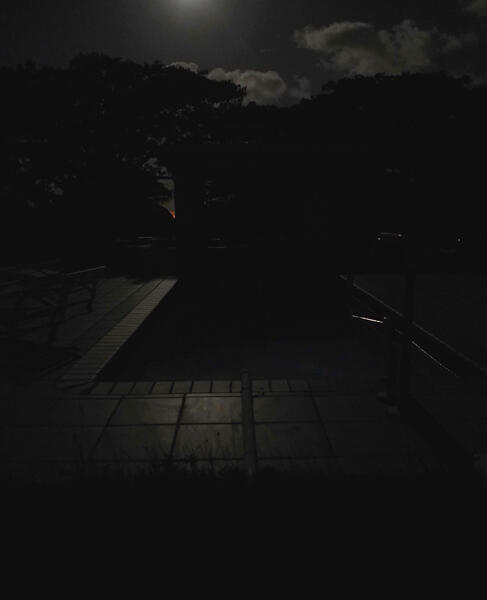 NightPoolNight Pool, 2015, Archival pigmented print, 20 x 15 View of a swimming pool in full-moon light
NightPoolNight Pool, 2015, Archival pigmented print, 20 x 15 View of a swimming pool in full-moon light -
 NightBogNineteen at Night, 2015, Archival pigmented print, 20 x 27 Night view of a bog with trees.
NightBogNineteen at Night, 2015, Archival pigmented print, 20 x 27 Night view of a bog with trees. -
CavaCave, 2018, Archival pigmented print, 15" x 20" View inside a wine cave.
-
 Sonoma Nights.jpgSonoma Nights, 2018, Archival pigmented print, 16" x 20" Night sky after fires in California wine country.
Sonoma Nights.jpgSonoma Nights, 2018, Archival pigmented print, 16" x 20" Night sky after fires in California wine country. -
 Asphalt LinesAsphalt lines, 2016, Archival pigmented print, 20" x 15" The smooth material repairing the road surface appears lighter in low light, emulating an abstract drawing.
Asphalt LinesAsphalt lines, 2016, Archival pigmented print, 20" x 15" The smooth material repairing the road surface appears lighter in low light, emulating an abstract drawing. -
 TerrazaTerraza, 2015, Archival pigmented print, 16 x 20 A terrace illuminate by full-moon light.
TerrazaTerraza, 2015, Archival pigmented print, 16 x 20 A terrace illuminate by full-moon light. -
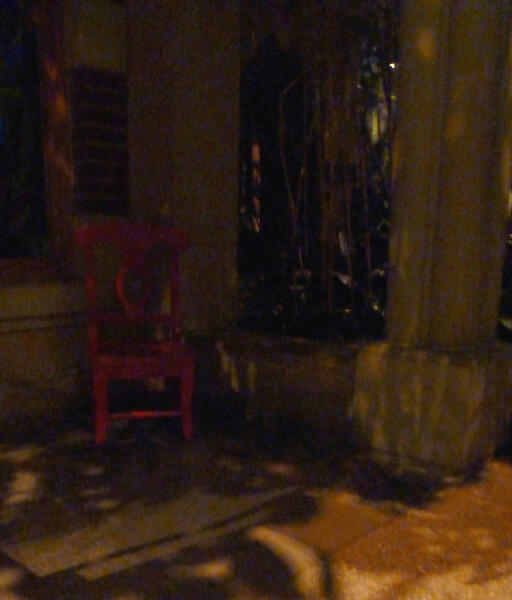 RedChairThe Red Chair, 2016, Archival pigmented print, 20" x 16" A nook inside Longwood Botanical Gardens at night
RedChairThe Red Chair, 2016, Archival pigmented print, 20" x 16" A nook inside Longwood Botanical Gardens at night -
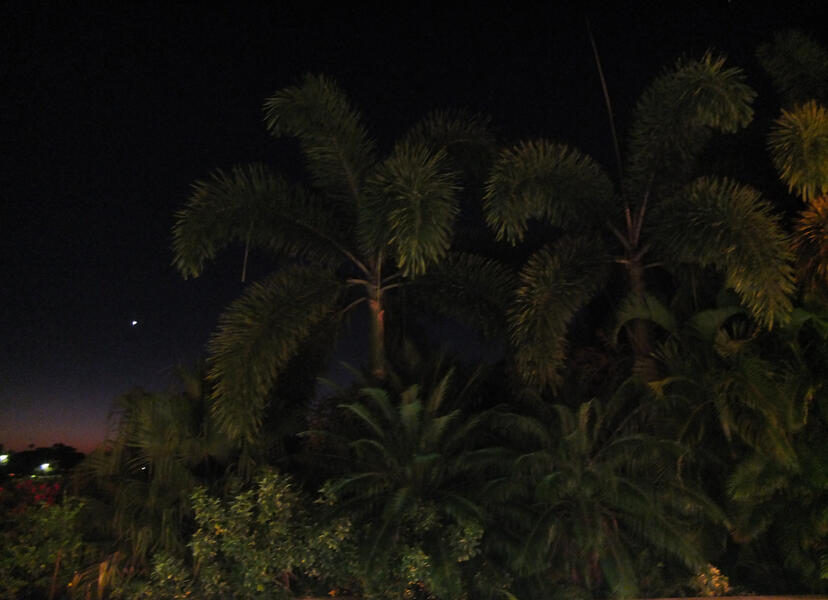 Destino NightDestino Night, 2014, Archival pigmented print,16" x 20" Garden viewed with only ambient night light .
Destino NightDestino Night, 2014, Archival pigmented print,16" x 20" Garden viewed with only ambient night light . -
 Greenhouse GrassesGreenhouse Grasses, 2017, Archival pigmented print, 20" x 15" Night view inside Rawlings Conservatory, Baltimore
Greenhouse GrassesGreenhouse Grasses, 2017, Archival pigmented print, 20" x 15" Night view inside Rawlings Conservatory, Baltimore -
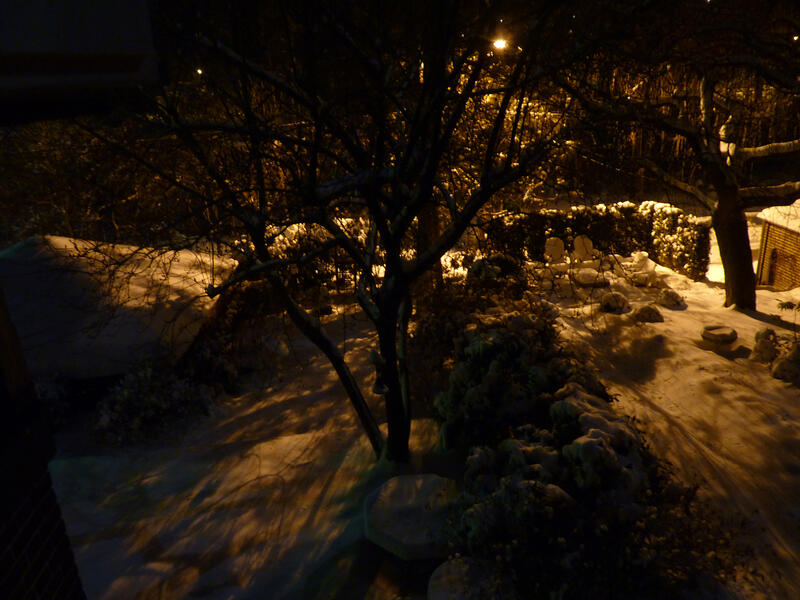 Nineteen At NightNineteen at Night, 2016,15" x 20" Night in a city yard under cover of snow
Nineteen At NightNineteen at Night, 2016,15" x 20" Night in a city yard under cover of snow
Nocturnals
I periodically work with the singular, low lighting found between dusk and dawn. While nighttime is very active in the natural world, human perception slows and changes. The process of taking night photographs differs from studio painting in that the nocturnals are less direct, cannot be hurried and is simultaneously an unnerving and engrossing procedure. Human is challenged in the dark.
“You understand that the stars are always here. They do not go away in daylight. It is that we can only see them in the dark. That is the good thing about the dark.” Caroline Herschel,19 c Astronomer
-
 Sido's CactusSido’s Cactus, 2019, Watercolor, Archival Digital Print on paper and Plexiglas, 40” x 26.75” The French writer, Collette, wrote a story about her mother, Sido’s, epiphyllum, a short-lived, night blooming cactus. She told of her mother's apology for canceling a visit to her daughter in Paris because her cactus would bloom shortly and she wanted to be there to witness it. Sido reminds us of life’s ephemeral nature and the precious choices we’re forced to make.
Sido's CactusSido’s Cactus, 2019, Watercolor, Archival Digital Print on paper and Plexiglas, 40” x 26.75” The French writer, Collette, wrote a story about her mother, Sido’s, epiphyllum, a short-lived, night blooming cactus. She told of her mother's apology for canceling a visit to her daughter in Paris because her cactus would bloom shortly and she wanted to be there to witness it. Sido reminds us of life’s ephemeral nature and the precious choices we’re forced to make. -
 Ames' OrchidAmes’ Orchid, 2012, Watercolor & Archival Ink Jet Print on Paper & Acrylic, 21.5” x 29” This orchid dispenses a scent at night, which attracts moths that will fertilize the blooms. The painted orchids were surrounded with a night photo of its natural environment; a moth and its flightline and are printed on the framing Plexiglas. It is a tribute to Oakes Ames, an early 20c botanist specializing in orchids and his wife, Blanche Ames, a botanical artist.
Ames' OrchidAmes’ Orchid, 2012, Watercolor & Archival Ink Jet Print on Paper & Acrylic, 21.5” x 29” This orchid dispenses a scent at night, which attracts moths that will fertilize the blooms. The painted orchids were surrounded with a night photo of its natural environment; a moth and its flightline and are printed on the framing Plexiglas. It is a tribute to Oakes Ames, an early 20c botanist specializing in orchids and his wife, Blanche Ames, a botanical artist. -
 Dames de NocheDames de Noche, 2017, Watercolor and archival ink print on paper and framing Plexiglas, 16” x 12” Night blooming plants give off specific scents to attract night pollinating insects. Shapes of the moon’s phases, to which all living things are subject, are printed on the inside of the Plexiglas.
Dames de NocheDames de Noche, 2017, Watercolor and archival ink print on paper and framing Plexiglas, 16” x 12” Night blooming plants give off specific scents to attract night pollinating insects. Shapes of the moon’s phases, to which all living things are subject, are printed on the inside of the Plexiglas. -
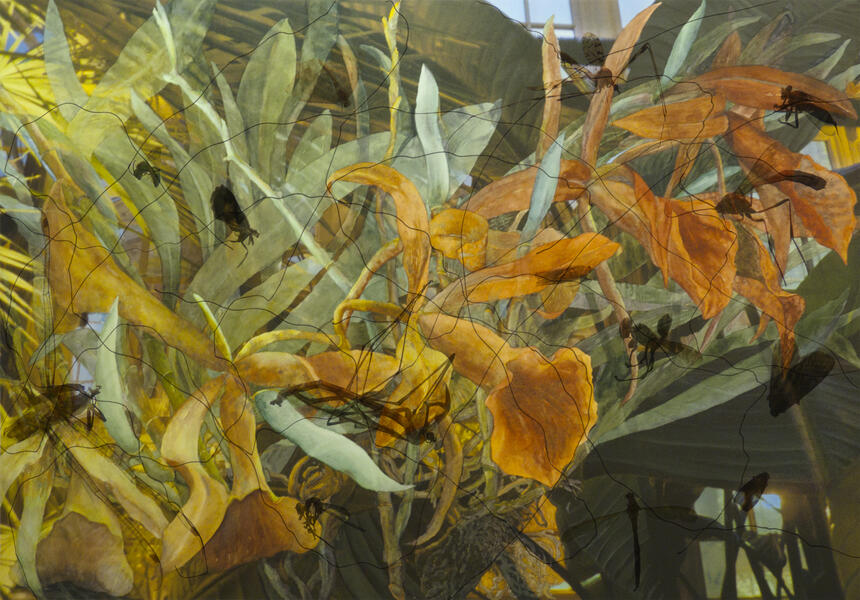 Night WingsNight Wings, 2013, Watercolor, archival ink jet print on paper & Plexiglas, 34" x 47” Many plants are night bloomers and release scents only at dark. Therefore, species of insects adapt their habits to become nocturnal feeders and pollinators. Scented night blossoms are painted in watercolor and surrounded by a print of a night photo. Night pollinating insects and their fight lines are photos printed onto the inside of the Plexiglas.
Night WingsNight Wings, 2013, Watercolor, archival ink jet print on paper & Plexiglas, 34" x 47” Many plants are night bloomers and release scents only at dark. Therefore, species of insects adapt their habits to become nocturnal feeders and pollinators. Scented night blossoms are painted in watercolor and surrounded by a print of a night photo. Night pollinating insects and their fight lines are photos printed onto the inside of the Plexiglas. -
 Flight LinesFlight Lines, 2012, Watercolor & Archival Digital Print on Paper and framing Plexiglas, 46” x 35.5” This orchid dispenses a scent at night, which attracts a specific species of moths to fertilize the blooms. The painted orchids were surrounded with a night photo of its natural environment. Moths and drawings of their fight lines have been printed onto the framing Plexiglas.
Flight LinesFlight Lines, 2012, Watercolor & Archival Digital Print on Paper and framing Plexiglas, 46” x 35.5” This orchid dispenses a scent at night, which attracts a specific species of moths to fertilize the blooms. The painted orchids were surrounded with a night photo of its natural environment. Moths and drawings of their fight lines have been printed onto the framing Plexiglas. -
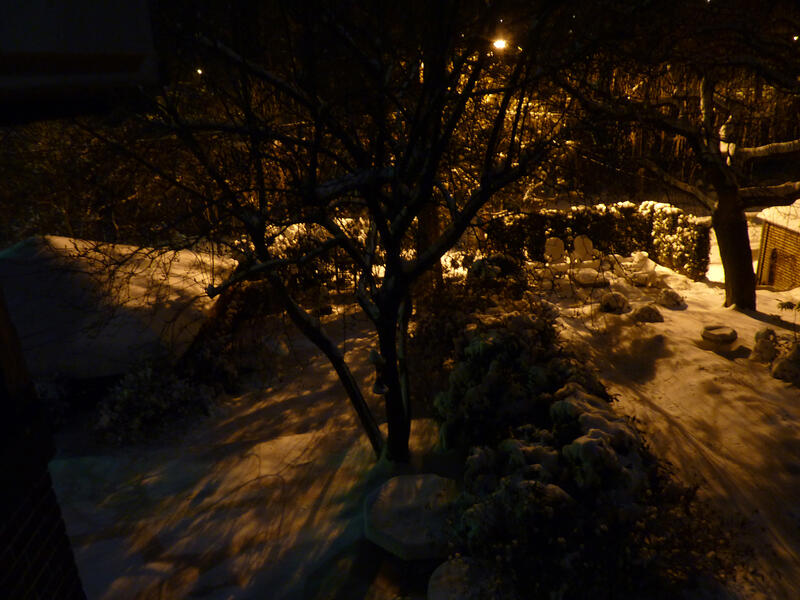 Nineteen at NightNineteen at Night, 2016, Archival digital pigmented print, 15" x 20" Night in a city backyard under cover of snow.
Nineteen at NightNineteen at Night, 2016, Archival digital pigmented print, 15" x 20" Night in a city backyard under cover of snow. -
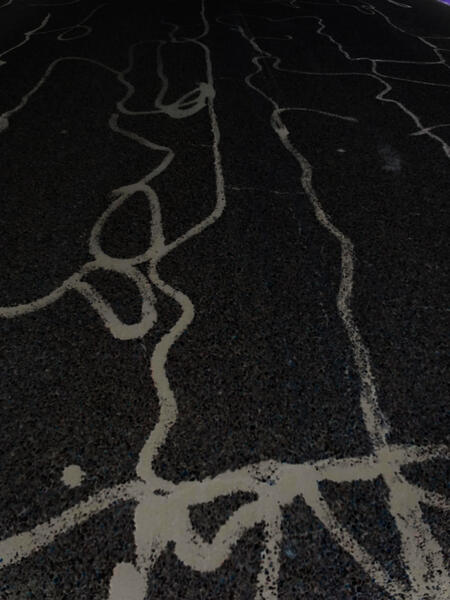 Asphalt LinesAsphalt Lines, 2018, Archival digital pigmented print, 20" x 15" Night view of a street repaired with asphalt calking.
Asphalt LinesAsphalt Lines, 2018, Archival digital pigmented print, 20" x 15" Night view of a street repaired with asphalt calking. -
 TerrazaTerraza, 2015, Archival pigmented print, 16" x 20" A terrace illuminate by full-moon light.
TerrazaTerraza, 2015, Archival pigmented print, 16" x 20" A terrace illuminate by full-moon light. -
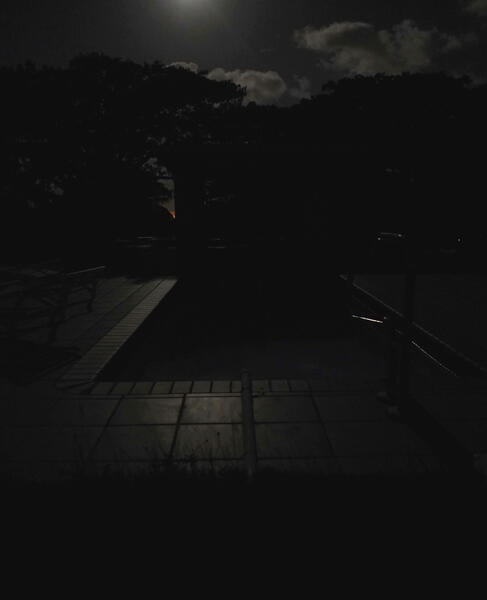 Night PoolNight Pool, 2015, Archival pigmented print, 20" x 15" View of a swimming pool in full-moon light
Night PoolNight Pool, 2015, Archival pigmented print, 20" x 15" View of a swimming pool in full-moon light -
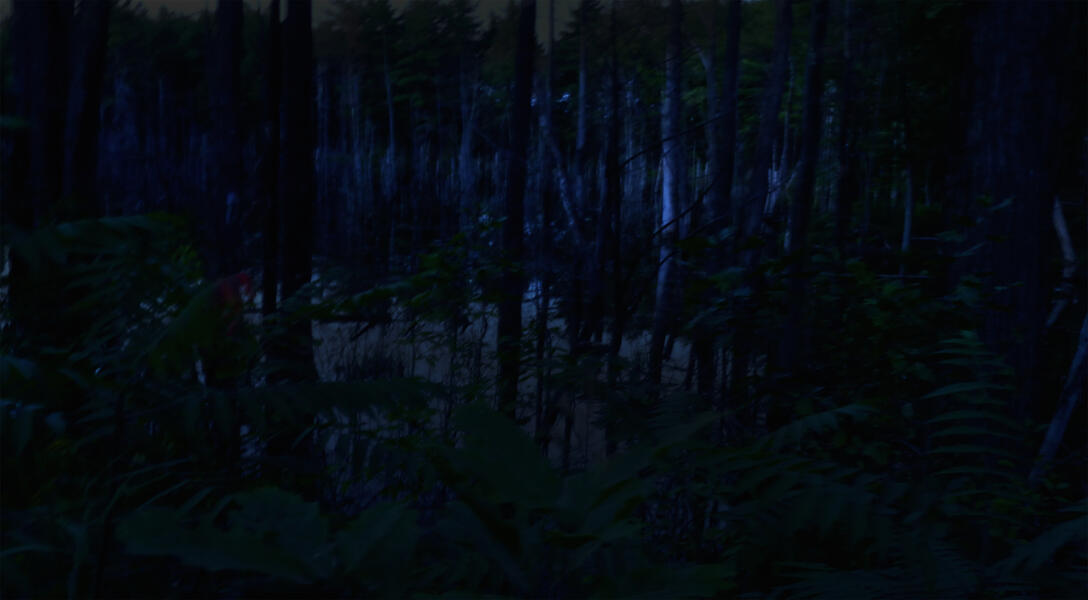 NightBogNight Bog, 2015, Archival pigmented print, 20 x 27 Night view of a bog through trees.
NightBogNight Bog, 2015, Archival pigmented print, 20 x 27 Night view of a bog through trees.
Monoprints
Printmaking is a process that parallels my layered paintings. Print techinques are a way for me to experiment with concepts, color and composition. In turn, the mixed-media watercolors influence the prints. I prefer the immediacy of monoprints and use non-toxic methods.
-
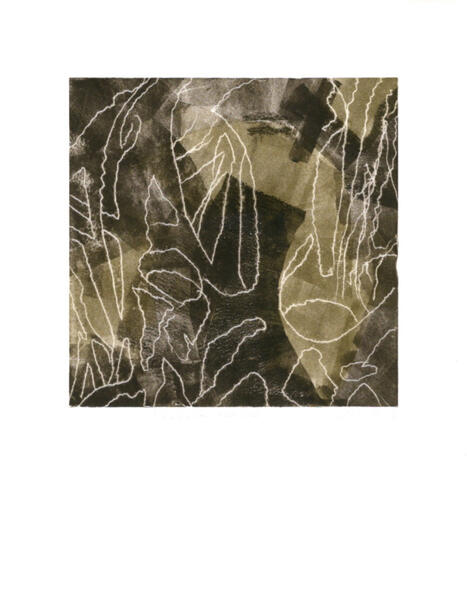 Field Guide-BranchesField Guide-Branches, 1/1, 2019, Trace drawing on Paper, 8” X 8”
Field Guide-BranchesField Guide-Branches, 1/1, 2019, Trace drawing on Paper, 8” X 8” -
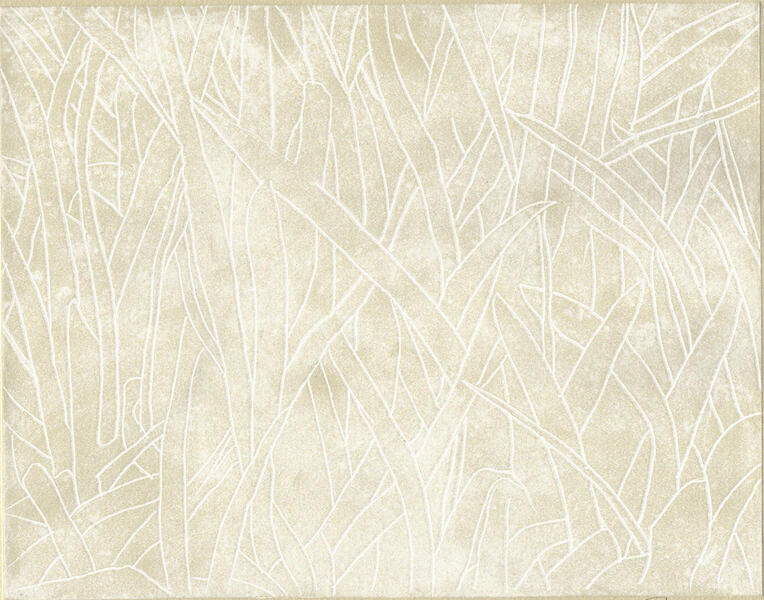 Field Guide-GrassesField Guide-Grasses, 1/1, 2019, etching on paper, 8” x 10”
Field Guide-GrassesField Guide-Grasses, 1/1, 2019, etching on paper, 8” x 10” -
 FieldGuide-Coral & ZooanthellaField Guide-Coral and Zooxanthelia 1/1, 2019, etching, embossing, 8” X 10
FieldGuide-Coral & ZooanthellaField Guide-Coral and Zooxanthelia 1/1, 2019, etching, embossing, 8” X 10 -
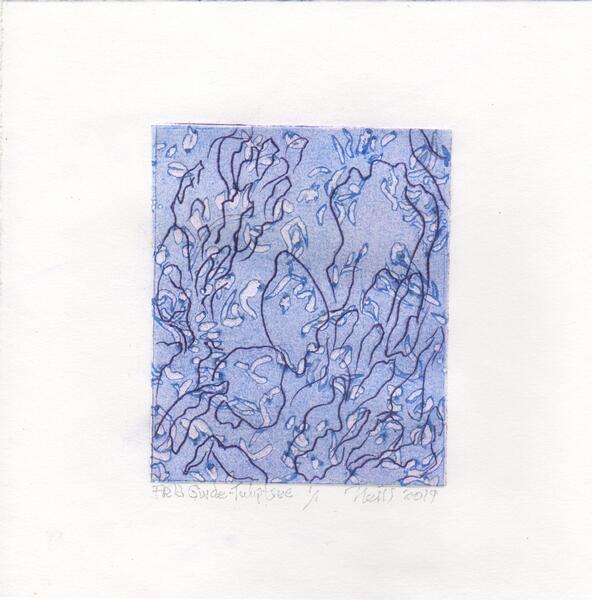 Field Guide--Tulip Tree BlueTulip Tree Blue, 1/1, 2019, etching, embossing on paper, 5” X 4”
Field Guide--Tulip Tree BlueTulip Tree Blue, 1/1, 2019, etching, embossing on paper, 5” X 4” -
 Field Guide-Systema NaturaField Guide-Systema Naturae 1/1, 2019, etching, embossing on paper, 10” X 8”
Field Guide-Systema NaturaField Guide-Systema Naturae 1/1, 2019, etching, embossing on paper, 10” X 8” -
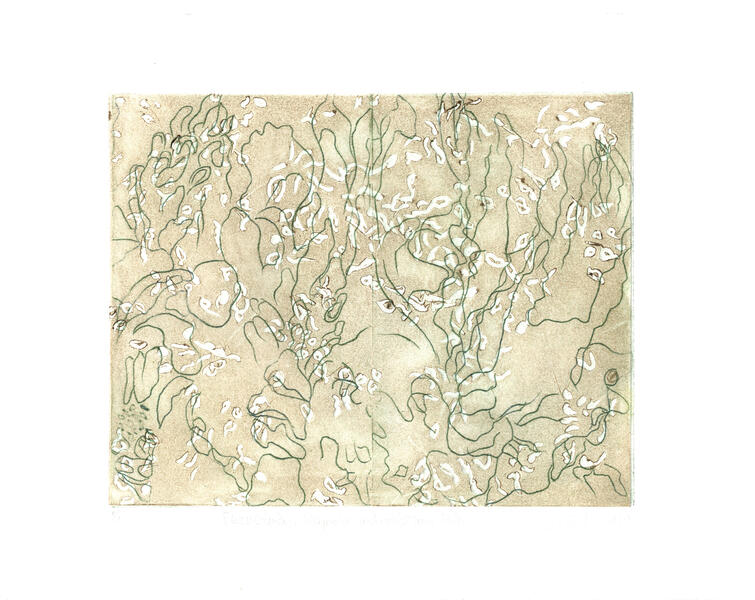 Field Guide-Magnolia and Tuliptree PodsField Guide-Magnolia and Tuliptree Pod 1/1, 2019, etching, embossing, 8” X 10”
Field Guide-Magnolia and Tuliptree PodsField Guide-Magnolia and Tuliptree Pod 1/1, 2019, etching, embossing, 8” X 10” -
 FieldGuide-Pods.jpgField Guide-Pods 1/1, 2019, Trace drawing, embossing on paper, 8” X 10”
FieldGuide-Pods.jpgField Guide-Pods 1/1, 2019, Trace drawing, embossing on paper, 8” X 10” -
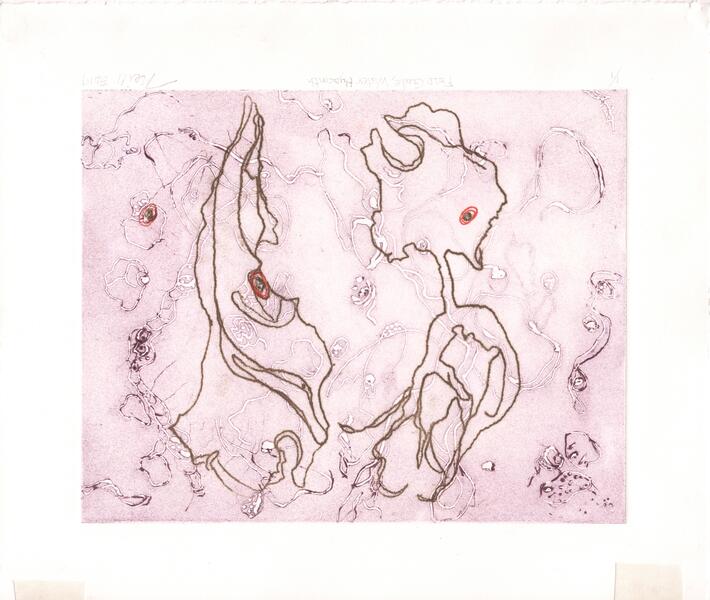 FieldGuide-Water HyacinthField Guide-Water Hyacinth, 1/1, 2019, Trace Drawing, embossing on paper, 10” X 8”
FieldGuide-Water HyacinthField Guide-Water Hyacinth, 1/1, 2019, Trace Drawing, embossing on paper, 10” X 8” -
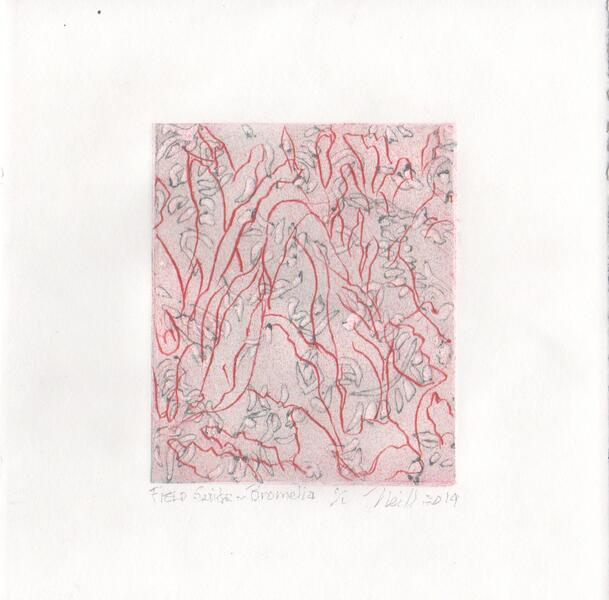 Field Guide-BromeliaField Guild-Bromelia, 1/1, 2019, etching, embossing on paper, 5” X 4”
Field Guide-BromeliaField Guild-Bromelia, 1/1, 2019, etching, embossing on paper, 5” X 4” -
 Field Guide-Magnolia GrandifloraField Guide-Magnolia Grandiflora, 1/1, 2019, etching, embossing on , 5” X 4”
Field Guide-Magnolia GrandifloraField Guide-Magnolia Grandiflora, 1/1, 2019, etching, embossing on , 5” X 4”
Professional Information
Text about one's work and achievments parallel the artist's studio practice. The reflective process of assembling a resume, revising bios and writing about the work helps ideas to evolve. These documents are always in progress. Included here are a photo of my studio, insights of what I and others have written recently, a Narrative Biography, Artist & Curator Essays, and Reviews.
-
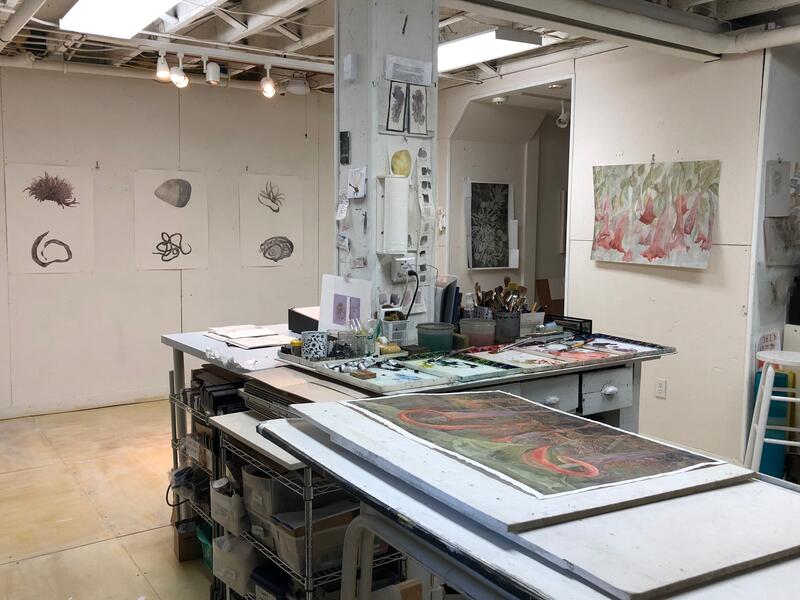 Neill's StudioNeill's Studio
Neill's StudioNeill's Studio -
2021 Essay2021 Essay
My work chronicles the ephemeral states of the natural world in layered mixed-media paintings and monoprints. By combining the immediacy of fluid paint mediums with digital processes, I interpret a lifelong fascination of biology and the environment.
Through observation of biotic phenomona, I note intersections where environmental and anthropological worlds meet.The effects of environmental changes and invasive species on human life, and the reaction of the earth’s habitat to these threats, underlie my investigations and images.
My practice typically involves scrutinizing the landscape for organic matter that suggests human activity or natural events. I line my studio with the collected specimens, which I research before making a series of drawn studies. Drawings and watercolors are created. As the layers coalesce, they depart from representation in favor of a visual translation of the object. -
2021 Narrative Bio2021 Narrative Bio
I had the good fortune to grow up in a family who valued being outdoors, education and the arts. Our Manchester, CT neighborhood backed onto wooded acres lined with old stone walls. Both parents were trained in the sciences, and for them, relaxation was building and maintaining our gardens. My maternal grandmother taught me to identify native wildflowers on woodland walks and took me to the Glass Flowers at The Harvard Museum of Natural History for the first time. Early on, our vacations were spent near Cape Cod Bay. In retrospect, it seems simple, safe and open to options and opportunity.
Memorable high school courses were biology and art, because both connected hands with the brain. -
2019Hanes Essay Endangered, Invasive, Beneficial2019 Stephanie Hanes Catalogue Essay ENDANGERED,INVASIVE, BENEFICIAL
Endangered
In early 2019, a group of international scientists made headlines when they warned that nearly a million of the world’s species were threatened with extinction. Around the same time, the IUCN – the International Union for the Conservation of Nature, which keeps the widely-cited “Red List” of threatened and endangered species – announced similarly dire findings. None of the species it analyzes had become more secure over the prior year, the group said. To contrary, nearly 30,000 of those 105,000 animals and plants were at risk of dying out, some imminently. -
Mark Jenkins, Washington Post ReviewReview of Neill's exhibit by Mark Jenkins, The Washington Post
November 28, 2019
In the galleries: At American University Museum, a world of atmosphere
By Mark Jenkins
The atmosphere is humid at the American University Museum, where Christine Neill, Pam Rogers, Lynn Sures and Mel Watkin are showing botanically inspired art.
In another age, Christine Neill might have spent her career celebrating nature’s beauty. There’s much of that in her “Observations From the Valley Floor,” but these delicate yet vigorous mixed-media pictures also contain intimations of disaster. Among the exemplary pieces are depictions of the fatal bleaching of coral reefs and the damage done by invasive insect species.



